 By Lisa Kearns By Lisa Kearns
April 24th, 2018
BURLINGTON, ON
This delegation sets out my position on item PB 33-18 – Community Benefits 421-431 Brant St. as Jim Young has delegated on behalf of ECoB this evening.
 Aaron A. Moore, Phd and expert on urban politics and public policy penned the IMFG Paper on Municipal Finance and Governance said the most common rationales used to invoke and justify the use of Section 37, more broadly know as density bonusing are: Aaron A. Moore, Phd and expert on urban politics and public policy penned the IMFG Paper on Municipal Finance and Governance said the most common rationales used to invoke and justify the use of Section 37, more broadly know as density bonusing are:
• funding related infrastructure upgrades
• sharing the wealth created by development
• compensating those negatively affected by the development
In review of the 421 Brant St. Inc. report, there are few indirect infrastructure supporting benefits. With the longer vision of pedestrian-oriented flex street and the impending anchor mobility hub provisions the closest benefits are:
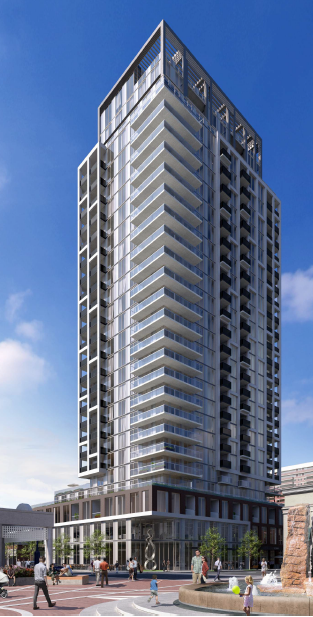 • $150K in streetscape improvements coupled with $250K in setbacks/widened view corridors. • $150K in streetscape improvements coupled with $250K in setbacks/widened view corridors.
In my analysis, much of this can be takes as part of the 5% parkland dedication and the initiative to broaden the streetscape could have been reviewed by increasing Schedule O in the Draft Official Plan to widen Brant Street from Lakeshore Rd. to Caroline Ave greater than the current 18m in order to satisfy the Main Street function of: Table 1 Transportation Facilities. 2.4. Main Streets:
Serve the Downtown Urban Centre and the urban corridor that connects the Downtown Mobility Hub to the Burlington GO Mobility Hub;
Support mixed use places that contain a pedestrian-oriented public realm and street-oriented buildings;
Accommodate high levels of pedestrian and cycling activity and transit service, and moderate levels of vehicular traffic, typically within narrower rights of way;
Accommodate a moderate to high degree of people-moving capacity.
One way this could be interpreted is that the negotiators of this Report PB-33-18 have in part, bought benefits they didn’t necessarily have to and could have drafted the benefits the City finds favourable into the draft official plan, which this application is required to be in compliance of, when this was perhaps a missed opportunity, in part and adds up to nearly a quarter of the value of the total benefits.
Did we negotiate too specific and too early?
Not limited to direct funding for infrastructure upgrades, cost avoidance for future pressures on infrastructure can fall in this same category. This is where I will allocate the provision of green technology and sustainable architecture. At an indirect community benefit of $300K, LEED certification standards and/or compliance with the City’s Sustainable Building and Development Guidelines have been negotiated.
Appendix E in report PB-62-17 draws in the Burlington Sustainable Development Committee which has recognition under the current OP provides that “to the greatest extent possible, proposed development shall be consistent with the goals of sustainable development”. While the general concept of this building is acceptable, there is no evidence of stewardship initiatives in the plans to use LEED at a certified level although a willingness was verbally indicated. Why include this benefit at the application phase when it can be advantageous at the bonusing stage, perhaps the weight should have been greater in the public comments to prevent this crossroads.
Sharing the wealth created by development. There is no doubt that there is a financial consideration in a project this large, we know that from the Altus Group Economic Report and the uptick in development revenues in the City budget, not to mention the on going tax base increase. But just how much is the increased height really worth and how should this be spread out amongst the indirect parties. While not nearly enough to purchase even one unit in this property, $300K in cash is better than the single option negotiated in the 4853 Thomas Alton Blvd. report PB-16-16 which requires commitment from a housing provider to deliver affordable housing on a long term basis.
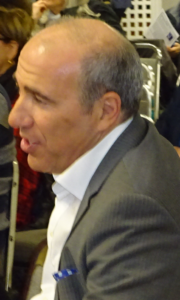 Kearns wants Carriage Gate developer Nick Carnacelli to think in terms of the opportunity for the applicant to help drive value out of being in a position of power for the community. Where I do take exception is to the Applicants’s previous delegation in such an absolute statement that “the Region of Halton does not have an affordable housing plan and the City does not have a program”, that is not to say that this excuses or discounts the real need and concern for housing affordability. In fact this is where an opportunity for the applicant to help drive value out of being in a position of power for the community by spearheading inclusivity through the Section 37 provisions.
A hard look should be taken on if this was the best we could get. Going beyond shouldn’t be just going beyond height, it should be going beyond basic requirements and setting the foundation to create a demographic mix that contributes to our vibrant downtown.
Toronto Star columnist Andrew Keenan muses that the purpose of Section 37 in the Planning act is to offset the problems caused by changes to a neighbourhood when different kinds of developments are added to it, such as to compensate for increased traffic, population, or changes to the streetscape new developments bring. We would deduce that the bigger the problems, the bigger the benefits.
The list of problems with this application have been captured through online comments, delegations, written submissions, coffee shop talks, emails and a current of anxiety and unease through the community. One resident’s submission on May 15, 2017 summed it up concisely, her excerpt reads“…insufficient parking for residents, only 2 elevators, no parking for visitiors, no parking for commercial tenants, change to the individual shops along Brant with a design that is completely out of context visually with the neighbourhood, shadows and traffic…this proposal does not belong in this location”.
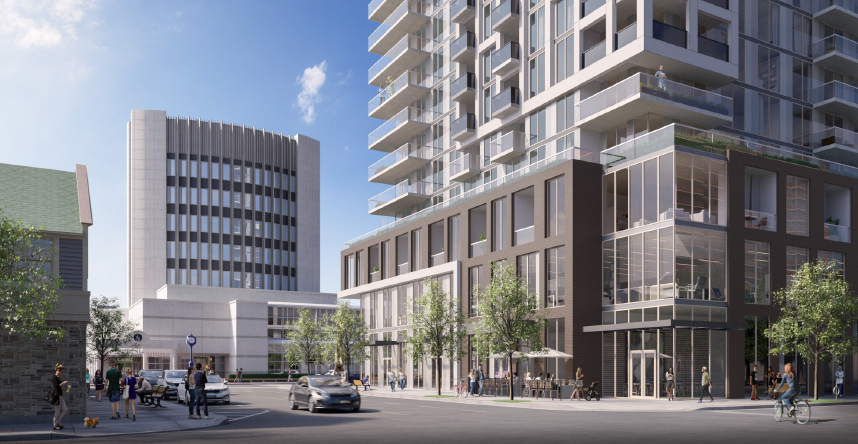 What will the impact of the 421 Brant development be on city hall – not just the physical impact but the impact on the way the city is going to grow. Alas, the Section 37 Benefits – a hefty $400K in privately accessible visitor parking, a quarter of the benefits to keep visitors out of the already contentious parking needs of the downtown. This could be viewed as a benefit, however, does it address parking for the 900 square meters of retail space? At minimum the recommendation for retail store stand alone is 1.5 spaces per 100 GFA that’s a minimum of 13 spaces, but we have 8. The comparison is easy to make that other stand alone retail doesn’t offer on site parking, however, if we are afforded a chance to improve this at the foundational level, does 8 private spaces address the spaces lost with no net benefit?
This provision is meant to compensate residents for the real or perceived effects of development by providing for new amenities in the neighbourhood. Public art, a covered promenade, and the remaining benefits do little to offset the anger that has swelled in the community around this application. There are no open community amenities, no greenspace compensation for more trees, nothing. These negotiations do not even come close to anointing the damage the neighbourhood perceives and feels.
The delegation, deferred from the last meeting, was to ask Committee to simply afford the public the same opportunity that the applicant was given to have an opportunity to openly delegate and tell this committee if they have succeeded in negotiating Section 37 benefits that truly align with building an engaging city, good governance and community building.
We know our City could have done better to Grow Smart, not just Bold.
 Lisa Kerns is a downtown Burlington resident and an active member of ECoB – Engaged Citizens of Burlington. She is also a self admitted policy wonk – she digs and figures out just what much of the baffle-gab means. Lisa Kerns is a downtown Burlington resident and an active member of ECoB – Engaged Citizens of Burlington. She is also a self admitted policy wonk – she digs and figures out just what much of the baffle-gab means.

 By Pepper Parr By Pepper Parr
April 23rd, 2018
BURLINGTON, ON
It was a Transit Forum that had people applauding and for the most part leaving the room satisfied that there were going to be changes made to the bus service in the city.
The public got their first chance to listen to the new Director of Transit, Sue Connor, who came to Burlington from Brampton where she turned that operation around. Transit users in Burlington are hoping she can do the same thing here.
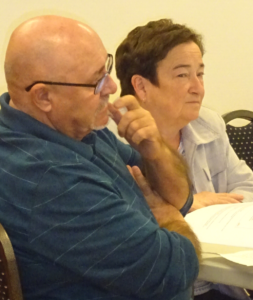 Jim Young joined Director of Transit Sue Connor on a panel discussion Connor came across as a little on the humble side. She admitted that there are problems and she believes they can be fixed but the fixing is going to take time and she will need money from the city to make it all happen.
Which of course has been Burlington’s problem for the past decade – the city has not been willing to put money into transit – shaving and paving the roads is where the dollars have gone.
Bfast founder Doug Brown cautioned Connor not to get fixated on just the capital side – the buying of new buses and fancy technology – he wanted to see dollars going into operations.
Connor talked of transit as a business – Brown cautioned her on that too – transit is a service he said.
The 4th Annual Transit Forum was the largest ever held – the event had to take place at the Seniors’ Centre where a larger room was available.
There were a number of differences this year – the city manager sent his deputy but she didn’t say a word.
Other than Marianne Meed Ward there wasn’t a city Councillor in sight. The Mayor was reported to be out of the country and ward 3 Councillor John Taylor was on a vacation – in Amsterdam.
With that kind of council member attendance one can get a sense as to how big a task Sue Connors has ahead of her.
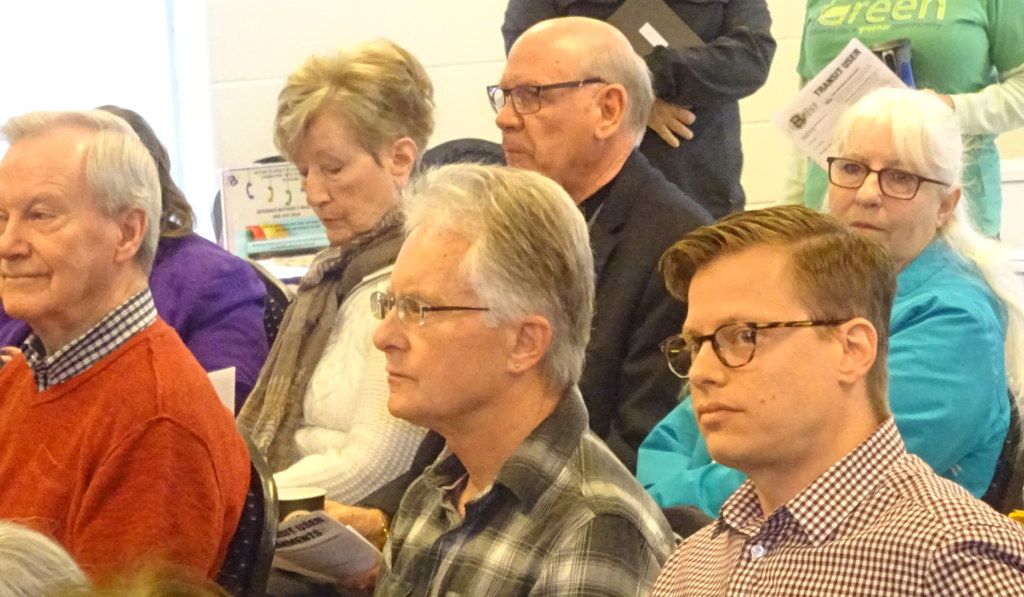 Ward 3 city council candidate Rory Nisan on the right with community advocate Gary Scobie in the center The hope, perhaps, is that there were at least five people who have announced they are running for office in the October municipal election.
There were a number of school board trustees in the room: Leah Reynolds and Richelle Papin.
Some people thought a new transit plan was going to be announced – that didn’t happen but the audience certainly heard about the $45 million the province has showered on the city for transportation. Eleanor McMahon, Burlington’s MPP, who is also running for re-election, said that we are “entering a golden age for transit”
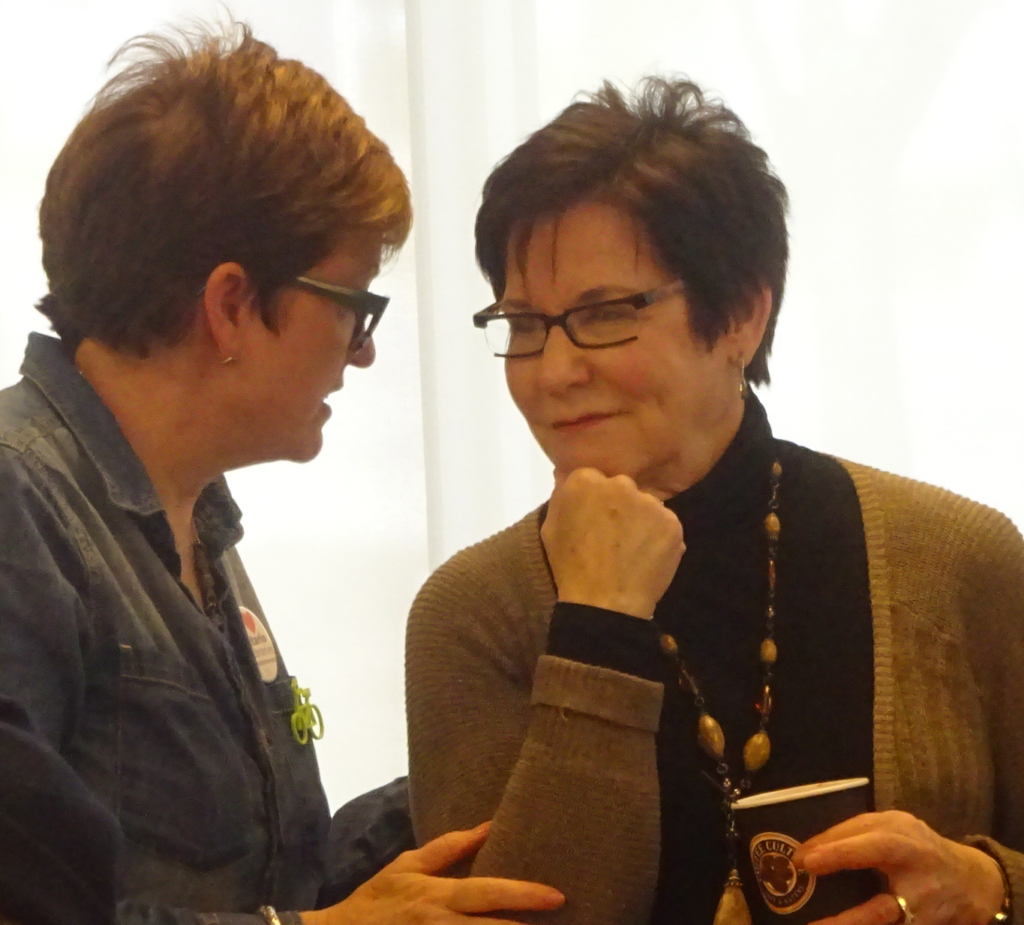 Burlington MP Eleanor McMahon on the left in full campaign mode bending Penny Hersh’s ear during a break in the Bfast Forum. She added that communities on the Lakeshore East and West GO lines will be the first to get 15 minute service – no date though on just when that will happen.
Doug Brown pointed out that Burlington has already experienced a golden age for bus transit – in 1982 the city has 15 minute service on every bus route.
He said that 2012 was a disastrous year for transit – gas tax money that went to transit was reduced from 30% to 20% and half a million dollars was taken out of the transit budget. A transportation Master Plan at the time took another half a million out of the budget by cutting back on the number of routes and service frequency.
Up until very recently Burlington didn’t offer any transit service on both Christmas and New Years Day.
Connor is working on a new plan for transit and moving at least some of the service from the current radial approach to more of a grid system. She wants to create a five year plan – her challenge is going to be to get it funded.
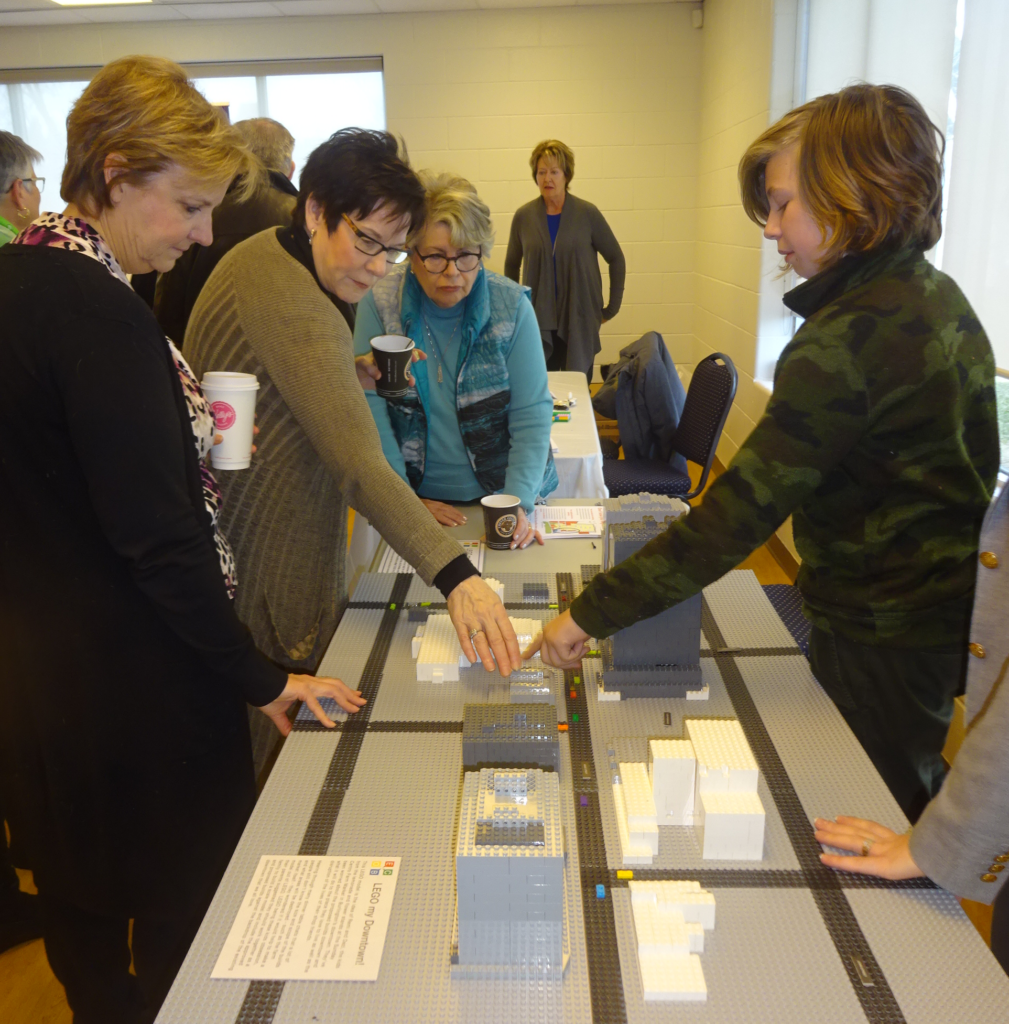 Transit and intensification are joined at the hip in Burlington. Citizens had wanted the city to prepare a 3D model of what the downtown core would look like once the high rise towers began to get built. City said they couldn’t create a model – so residents had students do something with LEGO. Former city planner and now Deputy City Manager Mary Lou Tanner looks over the model. She told the audience that there would be service changes in September and that her immediate focus is going to be on reliability – something the transit operation has not been able to do with the number of buses in the fleet and the number of operators on staff.
For the most part the audience had nothing but praise for the drivers – they always get a round of applause.
Some good news – Shoppers Drug Mart will become a part of the Presto card sales and refill operation.
The Downtown terminal will be open from 8-6 Monday to Friday and 9 to 6 on the weekends – and will no longer close at noon for lunch. There was a time when the then Director of Transit wanted to close the downtown terminals and have people hoof it over to city hall to buy bus tickets.
Connor told the audience that she has to first fix the foundation of the existing service and that she has a lot of work to do.
The audience learned that 80% of the transit traffic comes from half the routes
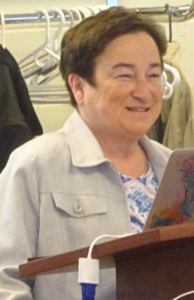 Burlington Director of Transit Sue Connor. Connor told the audience that she wants to dialogue with the community – words like that haven’t been heard a Transit Forums before. Connors came across as a nice lady who wants to make a difference.
Connor expects to take a report to city council sometime in June – at that point the audience that liked what she was saying Saturday will know if she can walk the talk,

 By Pepper Parr By Pepper Parr
April 19th, 2018
BURLINGTON, ON
The Bfast 4th Annual Transit Forum takes place on Saturday at the Seniors Centre – get there early and you can take advantage of the free Continental Breakfast.
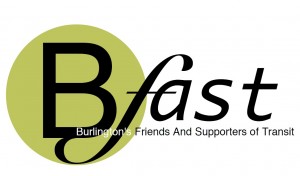 Bfast has been advocating for better transit for years – some of the people in the organization know more about the history of transit in Burlington better than anyone currently employed at the transit department. Bfast has been advocating for better transit for years – some of the people in the organization know more about the history of transit in Burlington better than anyone currently employed at the transit department.
They are closer to being listened to than they have in the past seven years. It has been a hard slog – the appointment of a fully qualified and respected transit executive has begun to make a difference. Sue Connor came to Burlington from Brampton where she grew that operation into one of the xxx
She will be part of a panel discussion and open for questions – this is the time for the public to let her know what they want and need and where the problems are – and there are a lot of them
The Vital Signs report produced by the Burlington Foundation highlights where some of the transit problems exist.
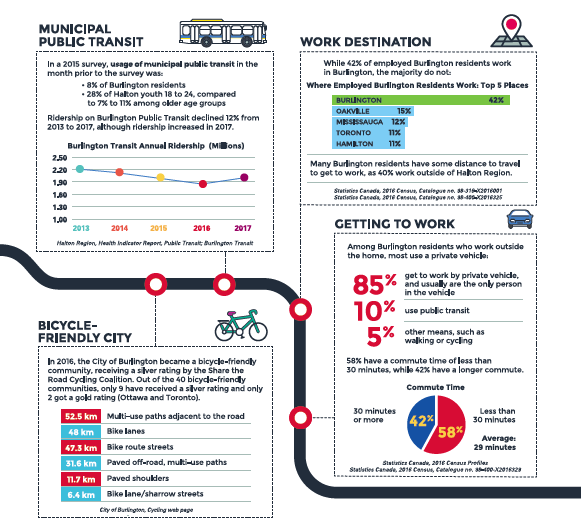 A partial snapshot of how people who live in Burlington get around or get to work Bfast have a deep understanding of the transit business – they have been delegating to council for years and for the most part have not been listened to – to some degree due to the poor management leadership at Burlington Transit.
There is much better leadership in place now; the recently appointed Director of Transit is a recognized and respected professional.
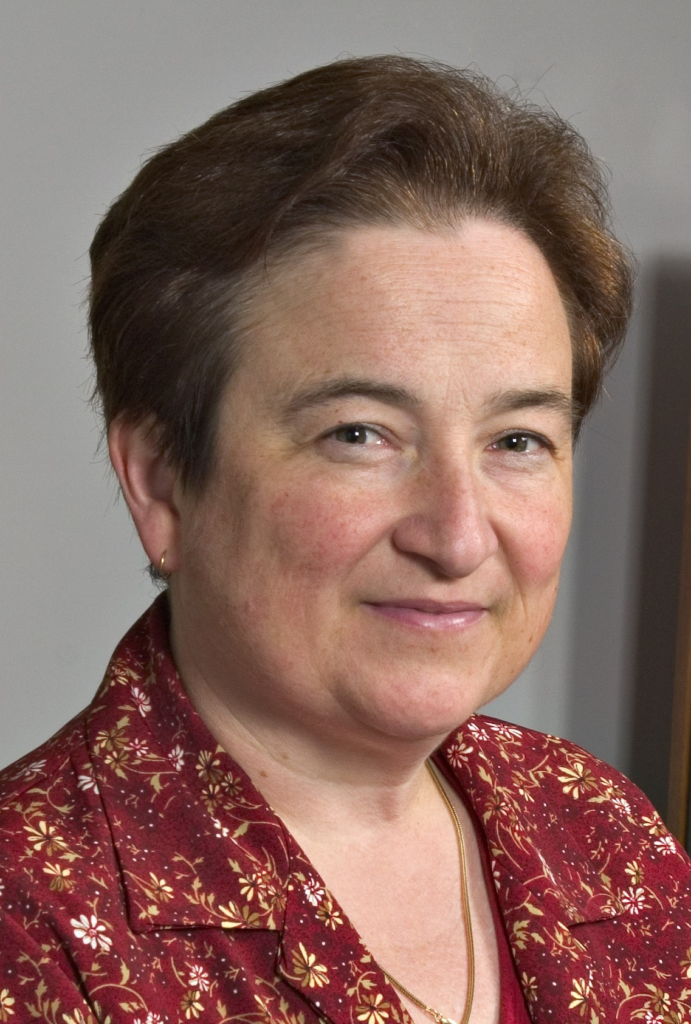 Sue Connor, Director of Transit. The problem Sue Connor will have is getting the funds she needs to upgrade both the transit assets and money for additional staff – and then some money to do some experimenting. Connor is probably part of the Burlington Leadership Team (City Manager James Ridge call it the BLT – not a sandwich). The challenge for her is to get some of the money the city has marked for infrastructure updates – there is a special tax levy dedicated to road repairs.
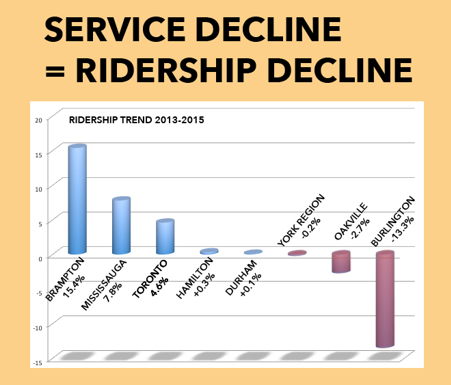 This is the picture Sue Conner got when she asked – How are things going? It wasn’t pretty. Burlington is some distance from ever creating a special tax levy to bring the transit service up to the level the the planners keep telling the public is going to be needed as a critical part of the Grow Bold initiative that is going to put something in the order of an additional 1000 people in new homes each year between now and 2031.
The planners keep talking about the need to get people out of their cars and maybe onto bicycles and transit. Connor is surely saying to her colleagues on the BLT – Sure – provide me with the funds I need to do just that.
There may be agreement between the transit people and the planners on what is needed – getting it through this council is another matter entirely.
Saturday is the public’s chance to make their voices and their opinions heard – but ya gotta be there to be heard.
Salt with Pepper are the musings, observations, thoughts, reflections and opinions of the publisher of the Burlington Gazette.

 By Pepper Parr By Pepper Parr
April 17th, 2018
BURLINGTON, ON
Stephanie Mah was completing a Master of Planning in Urban Development at Ryerson University and chose a Ride for Free program that had been initiated by Oakville Transit in Oakvlle Ontario.
In her Masters Thesis she said the “research investigated the Ride for Free Public Transportation program for seniors in Oakville, to understand their travel behaviour and to understand their perspectives towards taking public transportation.
While 63% of seniors in Oakville said that the Ride for Free Transit Program did not impact their travel behaviour, 37% said that it increased their public transit use. The most popular reason for seniors to use public transportation was taking it by themselves.
Some interview respondents said that they used public transportation because they would not have to ask others for rides or they did not have access to a car. Seniors suggested that more education of how to use the bus and transfer could increase senior ridership. This research may aid other municipalities considering similar programs, which could help to sustain the independent mobility of seniors.
Jim Young who was a member of the Burlington Seniors Advisory Committee, a group that advises city council on matters related to seniors, took the Mah research and prepared a proposal that he then took before city council as a delegation.
He proposed putting seniors on the mostly empty buses on Monday’s as a major first step to improving life and health for seniors. “It will help the city to achieve its transit utilization goals at a cost that is much less than the revenue loss” said Young who argued that allowing seniors to ride the buses during off peak hours will have a positive effect on the economy and well-being of the entire city.
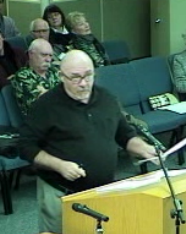 Jim Young delegating to city council. In his delegation Young added: “Discussion of this topic tends to return to the issues of cost and why a program only seniors and Split Passes users in need. The cost to put seniors on off peak buses from 10.00 am to 3.00 pm is the loss of revenue from present seniors fare during those hours. It amounts to between $48,500.00 per year and $72,750.00 depending on the rate of uptake.
“This is less than the amount of one senior’s lifetime city tax contributions. It is 1/10th of 1% of all taxes paid annually by Burlington Seniors. It is ¾ of 1% of Burlington Transit operating budget.
The subsidy from federal and provincial gas taxes works out to approximately $0.69c per passenger journey for Burlington. In 2015 Burlington seniors made 191,000 journeys. If free transit for seniors caused a 50% increase in ridership the increase in gas tax funding would amount to $66,000.00 which means that the free transit plan for seniors could pay for itself if properly implemented and utilized.”
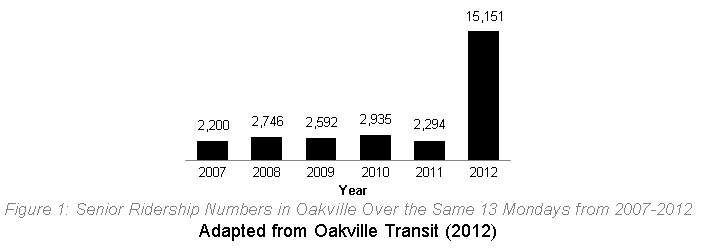 Data from the Oakville 13 week Free Monday transit pilot program. In her thesis Mah reported that survey results suggest that most seniors drive to participate in day-to-day activities and only a small proportion take transit. The survey found that most seniors in Oakville relied on the automobile as their main mode of transportation with 43.5% of seniors stating that they used the car at least five times or more a week and 34.5% of seniors stating that they never used public transportation. The pattern is similar to what has been reported in other studies. A high percentage of seniors (67.8%) had access to a car as a driver, and 60.3% had access to a car as a passenger.
Oakville implemented a 13-week “Free Transit for Seniors” Pilot Program for seniors over 65 allowing for free travel at no cost on Mondays. The Pilot Program results reported that senior ridership increased by 578% or by 12,917 trips on the same Mondays in 2011 (shows the dramatic increase of senior trips over the course of 13 Mondays from 2007 to 2012 (Oakville Transit, 2012) highlighting the positive impact of free transportation on senior ridership.
Young wanted the city of Burlington to pilot the Free Monday concept. Council did not take up the idea. The debate over possible Free Monday transit took place at the same time Burlington prepared to spend more than $200,000 on a pilot project to add bike lanes on new street and reduce vehicle traffic to just two lanes.
The Road Diet pilot was as close to a municipal disaster as one could get – except for the cost of the Pier.
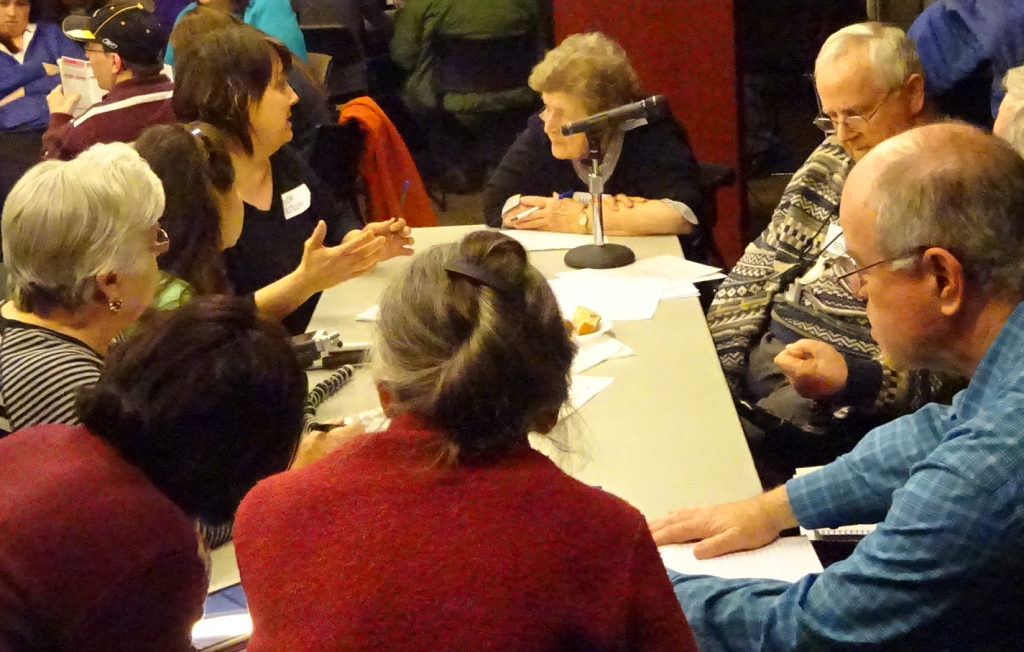 Transit users at Breakout sessions at 3rd annual Transit Forum. Bfast is holding their 4th Annual Transit Forum at a time when transit is getting more attention, a little more money and now has a Director of Transit who brings real transit experience and a well-earned reputation for growing transit services to meet public needs.
Hopefully the Oakville experience and the change in attitude towards transit will give the Oakville idea and the Jim Young proposal a second listen.
Salt with Pepper are the musings, thoughts, reflections and opinions of the publisher of the Gazette

 By Pepper Parr By Pepper Parr
April 16th, 2018
BURLINGTON, ON
Bfast, Burlington for Accessible, Sustainable Transit, is holding their fourth annual Transit Forum this Saturday, April 21st from 10:00 am to 12:30 at the Seniors’ Centre on New Street. Free continental breakfast for the early birds.
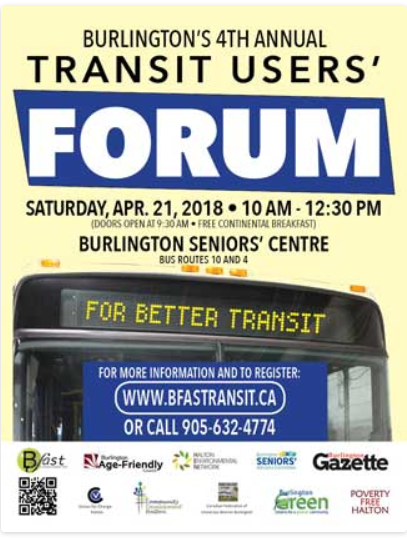 Burlington’s new transit director Sue Connor, a woman with a real transit pedigree will outline her plan of action for repairing and improving the system when she speaks at the Fourth Annual Transit Users’ Forum Apr. 21. Burlington’s new transit director Sue Connor, a woman with a real transit pedigree will outline her plan of action for repairing and improving the system when she speaks at the Fourth Annual Transit Users’ Forum Apr. 21.
Following her report, she’ll be part of a panel that will answer questions from the audience and discuss the issues that transit users raise. Panel members will be Jim Young and Glenda Th
Sue Connor was appointed to the job less than a year ago, but has already taken decisive action to make the system safer and more reliable. She helped to secure more than $1 million in new funding from City Council to hire more drivers, supervisors and mechanics to make Burlington Transit legally compliant and more reliable.
While the extra stopgap funding is welcome, Burlington Transit needs a greater commitment from City Council and a strong, sustained funding base, said Doug Brown, chair of Burlington for Accessible, Sustainable Transit (BFAST), one of more than a dozen community groups that support and sponsor the annual transit forum.
 Sue Connor, recently appointed Director of Burlington Transit. “We’ve made progress over the past year and Sue Connor’s appointment is a sign of that,” Brown said. “But we need to do more in order to bring Burlington’s transit funding in line with the rest of the GTHA.”
Connor, Chair of the Canadian Urban Transit Association, is well known for her success in transforming Brampton’s transit system, which has posted ridership gains in the double digits over the past few years. Burlington’s ridership showed double-digit declines over the same period due to the underfunding of transit services by Council.
Sue Connor, who is described as open, honest, frank with a real concern with solving riders’ problems, will speak to the riders of Burlington Transit,” Brown said.
This year’s Transit Users’ Forum will also feature the third transit users’ report card. Last year, more than 100 users rated the system and this year’s Forum participants will also determine Burlington Transit’s marks.
Community organizations participating in the Forum include:
• BFAST (Burlington for Accessible, Sustainable Transit)
• Burlington Age-Friendly Council
• Halton Environmental Network
• Burlington Seniors’ Advisory Committee
• Engaged Citizens of Burlington
• Voices for Change Halton
• Community Development Halton
• Burlington Seniors Community Inc.
• Canadian Association of University Women, Burlington
• Burlington Green
• Poverty Free Halton
• North Burlington
The Forum is supported by the Burlington Gazette and Burlington Transit.

 By Mark McGuire and Karl Wulf By Mark McGuire and Karl Wulf
April 4th, 2018
BURLINGTON, ON
Mayor Rick Goldring continues to provide a series of updates relevant to the vision of the Mayor’s Millennial Advisory Committee set out by Co-Chairs Mark McGuire and Karl Wulf in November 2017. This allowed committee members with an opportunity to ask questions to better understand how they can contribute to shaping their city.
Mayor Goldring identified the recent delegation by the Mayor’s Millennial Advisory Committee requesting Holiday Transit service as an example of a ‘win’.
Burlington was one of the few municipalities in Ontario that did not offer transit service on the holidays. The Millennial Advisory Committee delegated through a written policy brief to formally identify the gap in transit service.
Effective transit service is a key area that the Mayor’s Millennial Advisory Committee strives to influence, as greater intensification and limited space will mean more cars on Burlington’s streets and roads.
The Millennial Perspective
Mayor Goldring explained the process of influencing council. For the Burlington Millennial perspective to carry weight, it needs to be given early in the process by engaging with relevant stakeholders before community events and workshops that precede the relevant committee and council meetings.
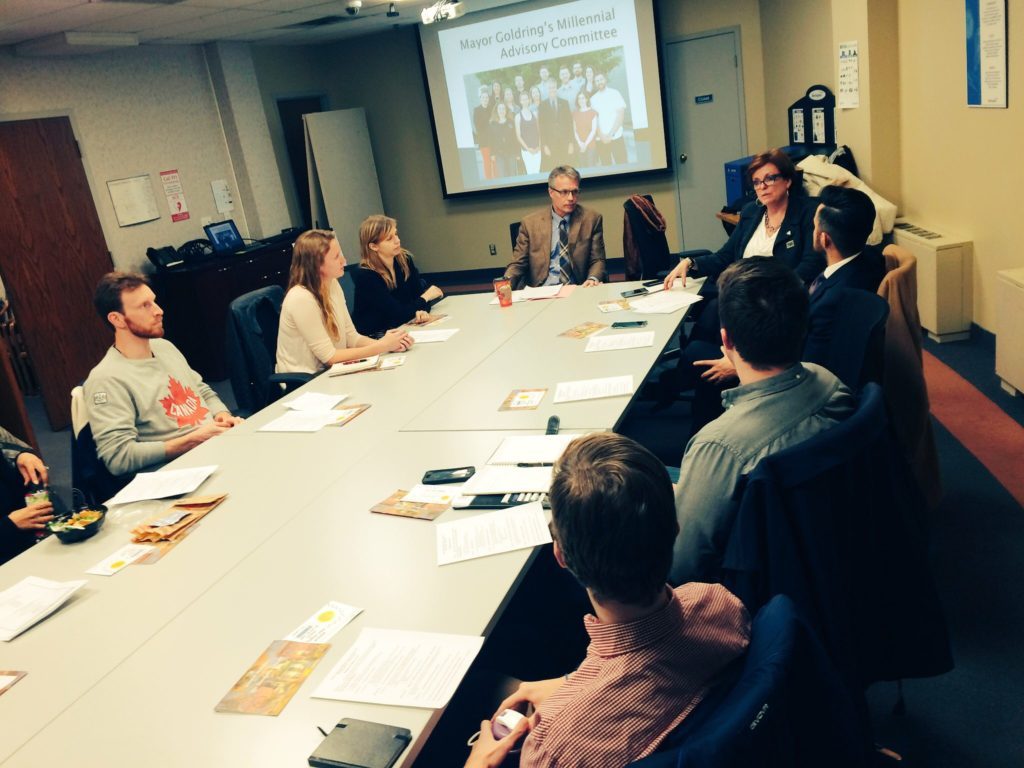 A session of the Mayor’s Millennial Advisory Committee meeting with Burlington MPP Eleanor McMahon A Vision Greater than Themselves
Mayor Goldring also discussed the importance of civic engagement, especially at early stages of projects within the City of Burlington. This led to a presentation by Co-Chairs Mark and Karl reiterating the three pathways for engagement the Millennial Advisory Committee is taking:
(1) Passive Engagement – Community presence and participation in Workshops;
(2) Reactionary Engagement – Delegating on contemporary topics at City Hall; and
(3) Proactive Engagement – Working with city staff to offer insightful policy critiques.
To increase the effect of the perspective of our generation in Burlington, it is increasingly more important to continue engaging at committee meetings and city workshops, but also to draft thoughtful policy proposals and send them to the proper stakeholders at City Hall.
The strategy is to lead a sustainable and influential committee of millennials in Burlington to build community engagement and provide advice and insights into policy impacting our city. This ties in with the mandate established by Mayor Goldring for the committee, “to lead projects focused on how to keep and attract residents 18-35 in Burlington.”
The Mayor’s Millennial Advisory Committee aims to be pivotal and to be perceived as the “Go To” committee for the City of Burlington to gain valuable insights into what our generation needs to continue to make Burlington the best place to live and work.
Civic Engagement
After discussing what is critical to millennials in Burlington through a collaborative approach with surveys from the Co-Chairs and workshops facilitated by Stephanie Venimore, Business Performance Advisor for the City of Burlington, the Millennial Advisory Committee has identified three key areas of engagement:
Commercial and Residential Development
Transportation
Burlington Culture
The Millennial Advisory Committee has delegated on mixed-use developments and transportation initiatives within the City of Burlington.
On multiple occasions, the Millennial Advisory Committee has provided key insights for important cultural projects, the Museums of Burlington Joseph Brant Museum project being especially important as it represents the cultural heritage of Burlington’s founder, Joseph Brant of the Mohawk.
Want to get involved?
If you are a millennial trying to get involved, then this is a chance for you to speak out on the things you think would attract more millennials to Burlington.
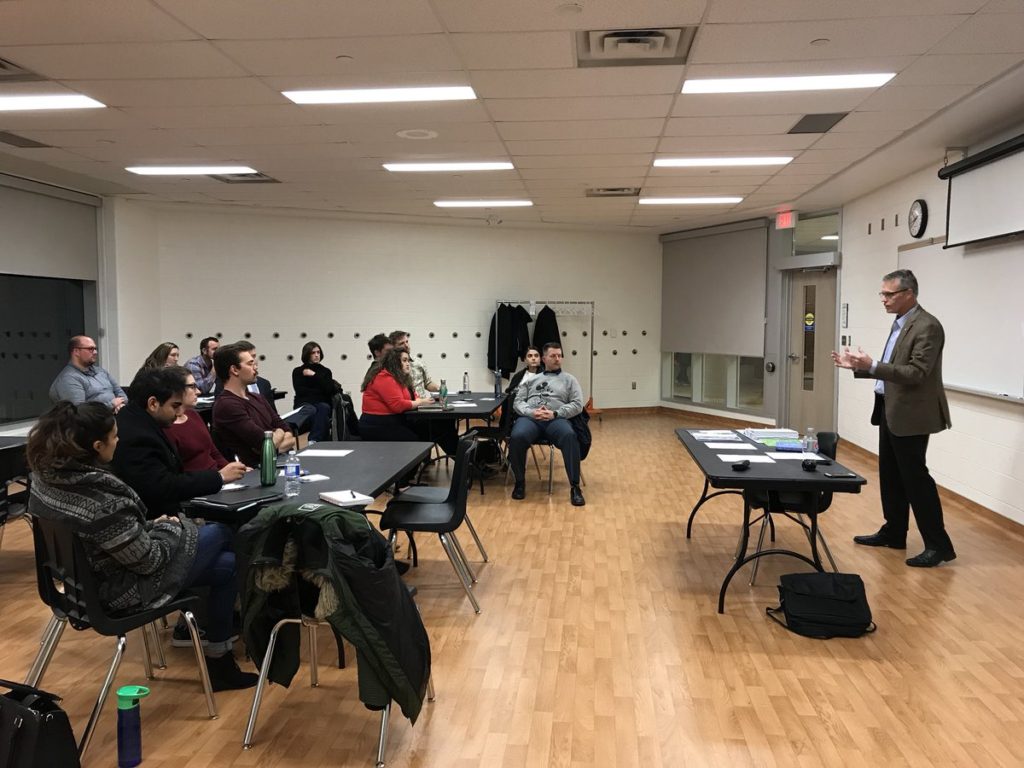 Mayor Rick Goldring making a presentation to his Millennial Advisory Committee. To apply to be a member of the committee, please email mayor@burlington.ca with the following information.
Name
Age
Primary email address
City of current residence
Social media accounts (Twitter, Facebook, Instagram, etc.)
Profession/Student status
A 500-word (max.) response to the following question: What ideas do you have for Mayor Rick Goldring’s Millennial Advisory Committee that would help meet its mandate of helping Burlington foster and retain millennial-age residents.
The Mayor’s Millennial Advisory Committee was created to develop initiatives and provide input on how to keep and attract residents aged 19 to 36 in Burlington. The Millennial Advisory Committee identifies millennials as people born from 1981 to 1998.
Why get involved?
The City of Burlington has the best reasons to get involved with any Committee or Board:
meet new people
share your talents
develop skills
address a common interest
make a difference in your community
Want more information?
Read the October Update from Term 2 Co-chairs Mark McGuire and Karl Wulf. You can keep up to date on the news from the Mayor’s Millennial Advisory Committee by visiting Burlington.ca/millennials.
For more information about the committee, contact the Office of the Mayor at mayor@burlington.ca
 The readership survey will close April 6th Mark McGuire and Karl Wulf, are the Co-Chairs of the Mayor’s Millennial Advisory Committee. This column first appeared in the Mayor’s Blog
Related articles:
Jim Young on citizenship engagement.

 By Staff By Staff
March 23, 2018
BURLINGTON, ON
The Gazette is currently running a ridership survey.
One of the question we asked was: Does Burlington need a higher level of public transit service?
 While incomplete, the survey data so far on transit is instructive. The survey will run for a number of weeks to give everyone a chance to have their say. The number of responses has been very healthy and there are some interesting results. At this point the best we can say is that there are some very clear trends – will they hold for the duration of the survey. We can’t say at this point.
We asked our readers this question: Does Burlington need a higher level of public transit service? Close t0 70% said yes. The Burlington For Accessible Sustainable Transit (Bfast) people have been saying this for years. It is only in the past six months that there has been the sense that city hall was listening.
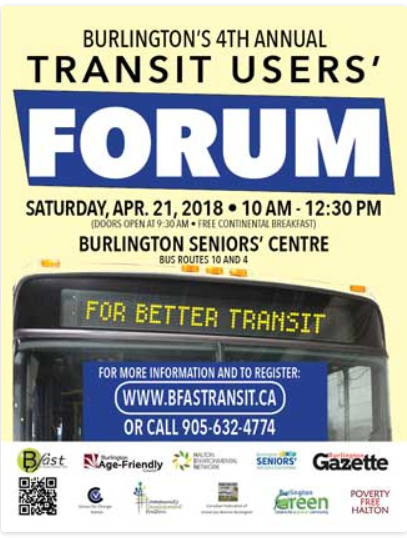 The Forum is one of the best organized citizen efforts to gather information and influence city decisions. One year the then Director of Transit chose not to attend; he is no longer with the city. Bfast has been a consistent, and we think very effective transit advocate. They are holding another annual transit feedback event.
They are beyond a doubt the most informed community group when it comes to transit in Burlington. Our research tells how Gazette readers feel about the state of transit in the city.
The Transit Users’ Forum is on Saturday April 21st at the Burlington Seniors’ Centre from 10 am to 12:30. There will be a free continental breakfast.
The city did a survey of their own earlier this month. The city appeared to want to find out what it is going to take to get people out of their cars and onto transit.
Director of Transit, Sue Connor, in a prepared statement said: “Improving Burlington’s transit service is a priority for the City of Burlington. As our population grows, providing a variety of convenient, reliable options to help people get around the city is essential. The Transit Plan, along with other city plans like the Transportation Plan and the Cycling Plan, will help to bring this vision to life. To help develop the Transit Plan, we want to hear from Burlington Transit riders to learn more about how they currently use public transit and equally as important, we want to hear from people who do not ride the bus to find out what might encourage them to consider transit. This information will help Burlington Transit start to improve its level of service.”
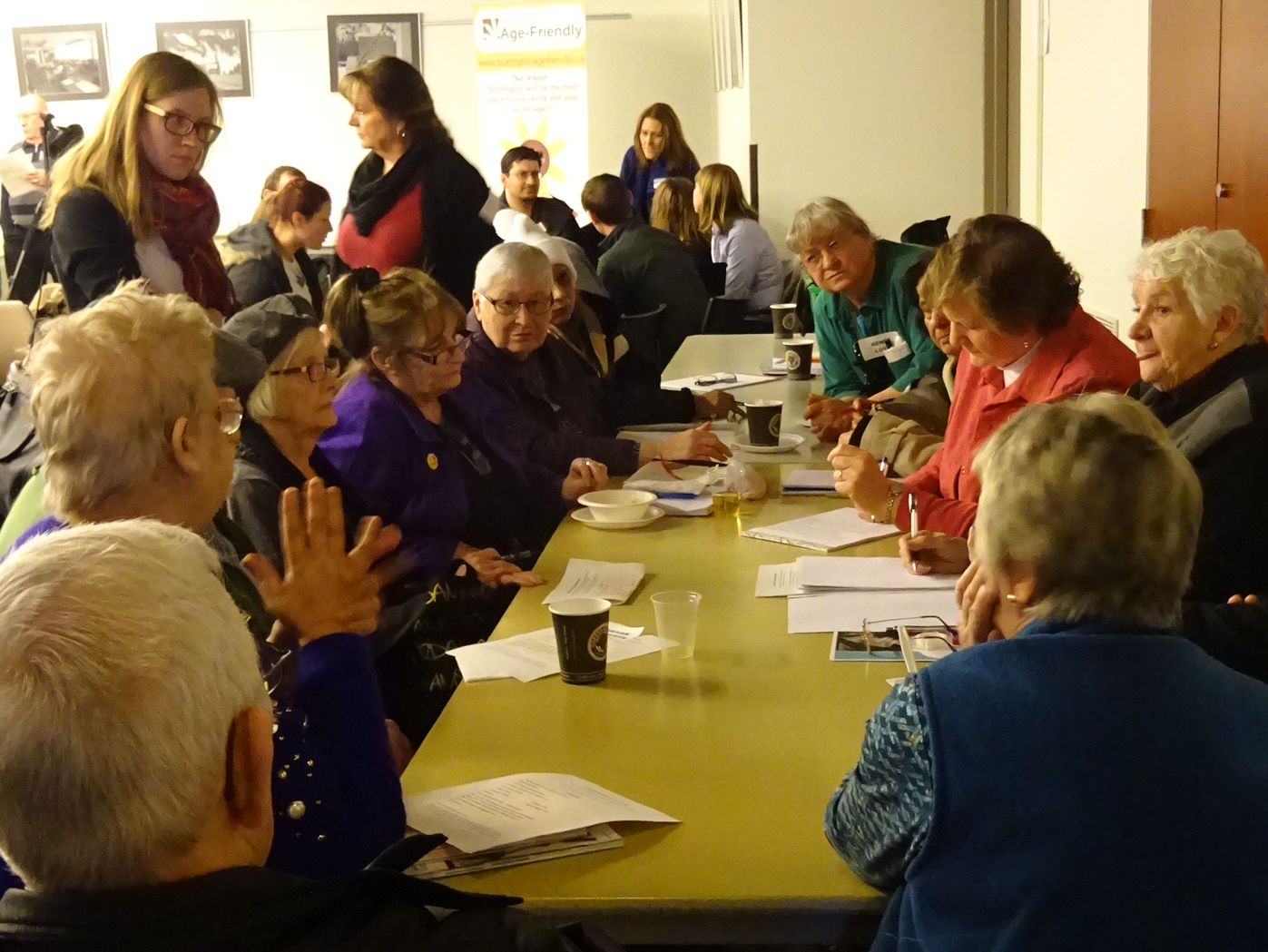 The Transit User Forums attract not only those who rise the bus. This photograph includes the Member of Parliament and the downtown member of city council. Public response to the survey did not appear to be all that high, the city sent out a second request asking people to complete the survey.
Stephen white, a vocal critic made this comment:
“There are likely five key target markets and customers for Burlington Transit: 1) seniors; 2) those who don’t drive; 3) GO Train commuters; 4) students; 5) persons on fixed income or social assistance who can’t afford a car. Start by identifying the commuting habits, preferred destinations, schedules and preferences of these people, and actively seek their input on scheduling. Certain commonalities and trends will emerge.
“Second, investigate communities in which public transit is working well to identify what they are doing that we aren’t. Case in point: St. Catharines Transit. They have 44 bus schedules compared to 26 I counted on Burlington Transit’s website. A friend of mine who lives in central St. Catharines tells me she can get anywhere in the city within an hour needing only one transfer. She comes to Burlington occasionally and bemoans the time lags and multiple transfers it takes for her to get anywhere here. St. Catharines has 60,000 fewer residents than Burlington. Why is their system so much better than ours?
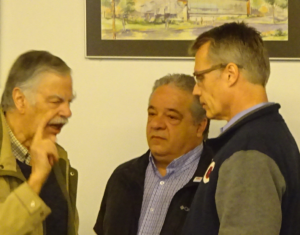 When a transit user is grumpy – they are really grumpy. “Third, let’s focus on doing a few things really, really well rather than spreading our resources too thinly. If it is problematic to design a public transit loop that integrates certain outlying neighbourhoods into the transit grid then fill in the gaps with dial-a-ride services or contracts with Uber. And let’s stop trying to persuade certain population groups to ride transit when, quite realistically, there isn’t a snowball’s chance in hell they will ever do so. A family of four on Saturday morning going to kids hockey practice, then McDonalds’s, then Rona, aren’t going to be riding Burlington Transit anytime soon.
“Finally, if it requires us to cut prospective clients a deal to get them on the buses, increase ridership and improve mobility then let’s do it. In 2010 Carol D’Amelio floated the idea of free public transit for seniors when she ran for Mayor. In Oakville a program lets seniors ride on certain routes on certain days. As a taxpayer I’d sooner pay for those in need to use the transit system for free on certain days or times rather than having the things travel empty.”
The last Transit Users Forum was very well attended. The next one should be interesting.

 By James Smith By James Smith
March 10th, 2018
BURLINGTON, ON
It’s very refreshing to see both a City Manager and a Transit Director with a commitment to Transit after decades of administrative incompetence and political dogmatic undermining of the file. While competent management is welcome it will take citizens committed to having new civic leadership with some vision and spine this fall to really improve transit.
Perhaps if folks decided it was time for most of the tired old fogeys on city council to retire; real change might come to transit in Burlington. Hope springs eternal for competent civic leadership, but history is a cruel master.
 Burlington’s Friend and Supporters of Transit has been a consistent and positive voice for better transit. They did more to make the issue public than the Transit service did. The challenge for all cities right now on the transit file is confronting the big lie of “doing more with less” that has become gospel. Municipal councils will claim to keep their taxes to the rate of inflation. Sounds good, nobody wants to pay more taxes, but the largest single budget envelope under municipal control, police budgets, continue to expand. The obvious result is every other item faces a cut to service as other wages, fuel and capital costs continue to rise.
Without a commitment to Transit, and the will to fund it properly, little wonder transit in Burlington is where it is today. Burlington has dishonestly claimed for years that it has “kept taxes low”, while seeming true on the surface this is the result of Burlington getting a free ride from the Region’s budget take of massive, one time, development charges from the rest of Halton. These development charges continue to pay for services in Burlington keeping tax increases artificially low.
Cities such as Burlington could potentially be entering into a very dark period, not just for transit but for all city services. There is a very real chance the Conservatives may come to power at Queen’s Park. There’s no coincidence that a lost decade of transit in Ontario was the direct result of the hit transit took during the Harris/Eves administration. Provincially it has taken more than a decade to fix many files that were cut or ignored during that time, this is especially true in the case of transit. Part of the likely Conservative agenda is the big lie that “tax cuts will spark the economy”.
So read this as Conservatives cutting funding for many programmes, will transit escape the knife? Look at their leadership hopefuls and their track record.
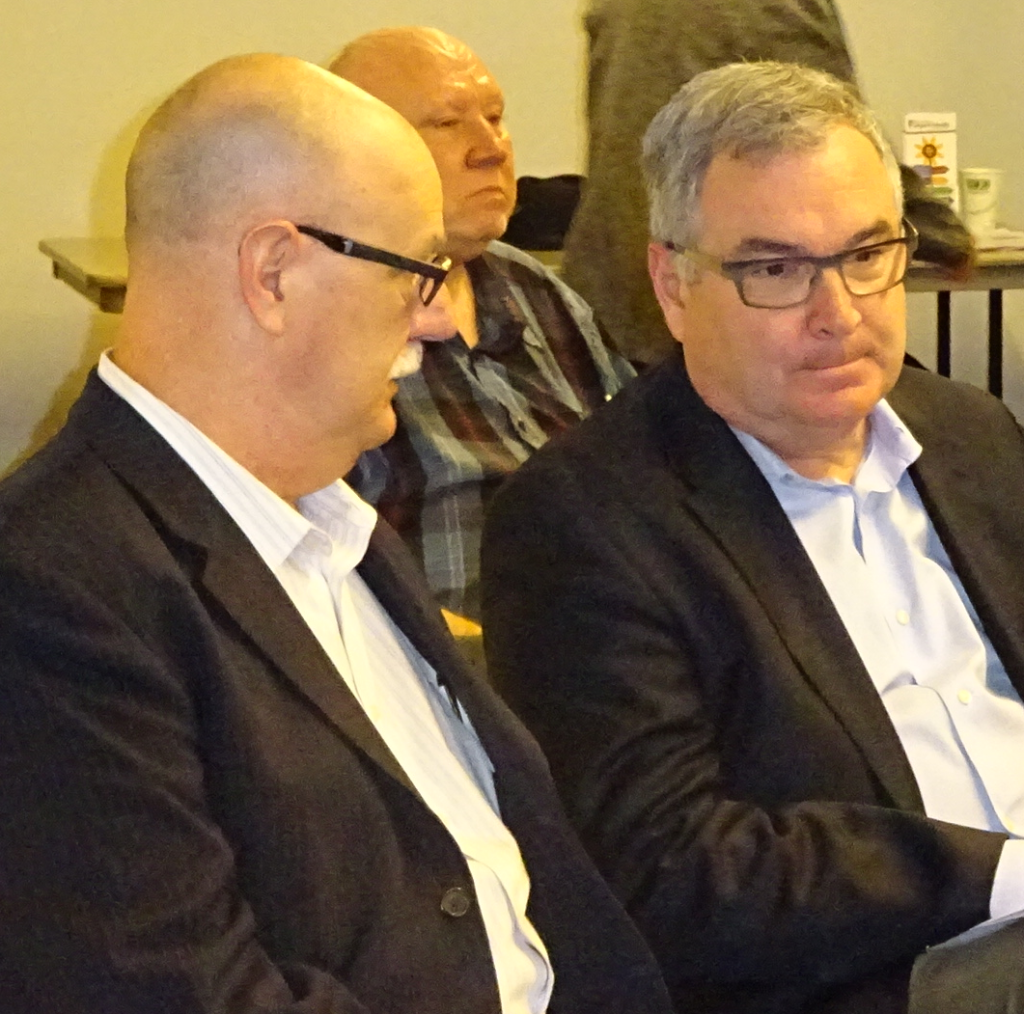 City manager James Ridge with former Director of Transit Mike Spicer at an event organized by citizen transit advocates. Spicer resigned as Director not that long after this picture was taken. In the past few years, Ontario has had a government that’s at least has claimed to have been committed to transit and has gotten the province back in the game. Given Burlington Transit has just managed to kept the lights on under this regime it begs the question: How bad will it get for transit with a Provincial administration that doesn’t have this commitment to Transit? How bad will it get for transit if we have a provincial government that denies the validity of climate change science?
How bad will it get for transit with provincial leadership hopefuls who think of transit as the enemy of drivers? Given the city of Burlington’s track record on transit, and the potential of a conservative provincial government, I suspect that the light seen from the new city manager and new transit management at the city of Burlington is that of an oncoming freight train; no passengers allowed.
 (James is an award winning Contract Designer, Past member of BFAST, Co-author of the 2014 Western GTA Move Taskforce Report, and Former President of Friends of Freeman Station. James Smith and his wife were 27 year residents of Burlington and now make their home in Guelph.) Smith ran in the 2014 municipal election against Paul Sharman (James is an award winning Contract Designer, Past member of BFAST, Co-author of the 2014 Western GTA Move Taskforce Report, and Former President of Friends of Freeman Station. James Smith and his wife were 27 year residents of Burlington and now make their home in Guelph.) Smith ran in the 2014 municipal election against Paul Sharman

 By Staff By Staff
March 5th, 2018
BURLINGTON, ON
If you do not use public transit in Burlington – the city wants to hear from you.
Burlington and transit have not always had a smooth relationship.
The city has in the recent past not put much money into transit use. They did put in $1.55 million in the 2018 budget and say they plan to put in much more.
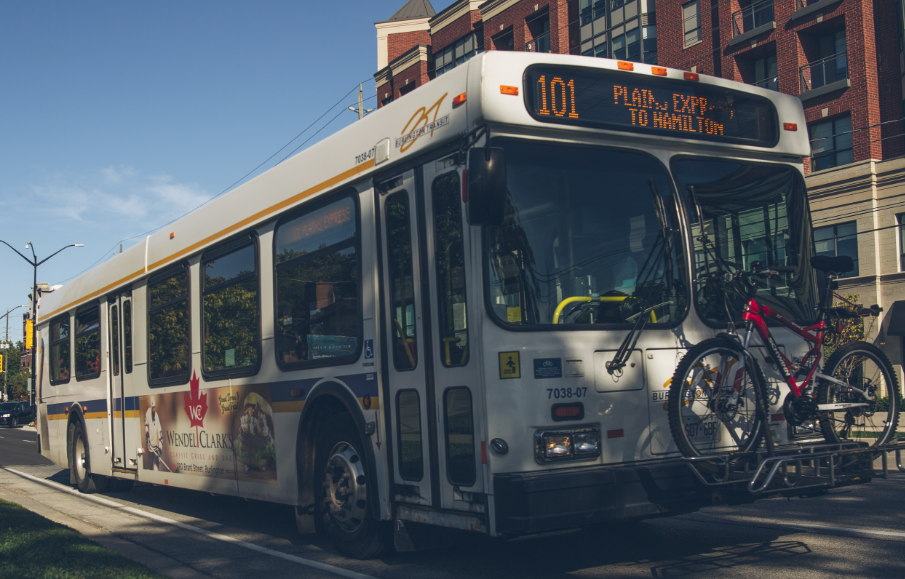 In a perfect world this bus would be at least 3/4 full and maybe two bikes in the front end rack. Not there yet and the city wants to find out why. Given that the city touts transit as the way of the future, that and bicycles – major dollars are going to be needed to create a transit system that people will want to use.
The voice from city hall:
Calling all Burlington Transit riders and non-riders: Help build a better Burlington Transit
The City of Burlington wants to hear from Burlington Transit riders and individuals who currently do not use Burlington Transit about their thoughts and experiences with public transit in the city.
The information gathered from the public will be used to help shape a Transit Plan for Burlington that will guide the development of a new transit network that meets the needs of the city’s growing population over the next 25 years.
Feedback can be shared by completing an online survey available until March 26.
 Sue Connor, Director of Burlington Transit Sue Connor, Director of Burlington Transit, has settled into the job quite well apparently. A report that was put in the hands of the city manager a number of months ago stunned many – the city was offside on a number of levels.
That report got the $1.55 million into the 2018 budget.
The city now appears to want to find out what it is going to take to get people out of their cars and onto transit.
Connor, in a prepared statement said: “Improving Burlington’s transit service is a priority for the City of Burlington. As our population grows, providing a variety of convenient, reliable options to help people get around the city is essential. The Transit Plan, along with other city plans like the Transportation Plan and the Cycling Plan, will help to bring this vision to life. To help develop the Transit Plan, we want to hear from Burlington Transit riders to learn more about how they currently use public transit and equally as important, we want to hear from people who do not ride the bus to find out what might encourage them to consider transit. This information will help Burlington Transit start to improve its level of service.”
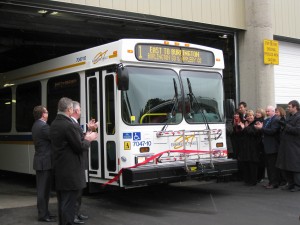 Senior staff applaud the roll out of a new bus. Some background:
The Transit Plan will be a multi-year plan that will guide new investment in a new transit network for the city that aims to:
Increase frequency and reliability of bus service
Focus service on the city’s most heavily travelled streets
Create better connections with other major transportation systems like GO rail who will increase the frequency of their service to two-way, all-day service every 15 minutes by 2025.
Improve the comfort and convenience of taking transit.
A report about Burlington’s Transit Plan is expected to be presented to Burlington City Council in May 2018.
On Jan. 29, 2018, Burlington City Council approved an investment of $1.55 million in transit as part of the city’s 2018 operating budget to provide stability to Burlington Transit’s operations and improve the reliability of the public transit service. Funding of $500,000 was also approved in the city’s 2018 capital budget for the installation of video cameras on buses.
Burlington is growing. The 2016 Census data shows Burlington grew by 7,535 people between 2011 and 2016 – a 4.3 per cent overall growth rate. Ontario’s Places to Grow Act mandates that Burlington plan for a population of 193,000 by 2031, however, the city will reach this population number within the next few years.

 By Pepper Parr By Pepper Parr
February 16th, 2018
BURLINGTON, ON
On March 1st there will be a council Workshop about the Code of Conduct for members of city council that the majority of this council just do not want.
A Code of Conduct was discussed at some length on a number of occasions during the first term of this council in 2011.
At a meeting in July of 2015, the last meeting before Council went on their six week summer vacation in the summer of that year, Councillors Craven and Sharman had a discussion in the foyer outside the Council Chamber. Both went to their seats when the conversation concluded; Sharman said a few words to Councillor Lancaster who sits beside Sharman and the meeting began.
Later in the meeting Councillor Lancaster introduced a motion, seconded by Councillor Sharman to replace wording in the Code of Conduct that had been taken out at an earlier meeting.
No one had seen the motion until it was introduced – not the Clerk or the Mayor. All the chatter about professionalism and respect for each other got blown out the window.
The final vote on what to do with the Code of Conduct was to refer what had been done up to that point to the City Manager who assured council he would move with some dispatch; debated under the Governance section of the Strategic Plan. One of the problems is that Strategic Plan meetings are for the most part not recorded or broadcast on the city’s web site.
The firm that provides Ombudsman support services to the city, ADR Chambers prepared a detailed document on this for staff; the City Clerk worked hard to get a document in place – council didn’t let it happen.
Among the issues that cropped up during the 2010-2014 term of office was whether or not the council member for ward 2 could involve herself in the affairs of ward 1. No love lost between those two.
The matter of what was a gift to a council member and what wasn’t a gift got debated as well as what the ramifications to a council member would be should they happen to be off side.
The Gazette published articles on this in in July of 2015 and again in November of 2015 when the issue was discussed on Cogeco cables The Issue.
There was another article on November 16th, 2016 and on January 30th, 2016.
Earlier this week there was a Committee of the Whole meeting that agreed to have a Task Force formed on bullying and harassment in the city. The members of council feel there is just too much harassment being aimed their way and they want to see some rules in place to manage this behaviour.
What a bunch of hypocrites; they are complaining about the way citizens with well founded concerns about the way growth is being managed who will not ensure that there is a Code of Conduct governing their behaviour. There has been a code in place for city staff that is enforced. What’s good for the goose doesn’t appear too appeal to the gander.
Bullying – what does one call the letter sent to ECoB by the City Manager threatening legal action if they did not remove some of the content on their web site. A conversation inviting the ECoB people to meet with the City Manager and talk about the information that was on the web site could have resolved the issue.
No carrots in the office of the City Manager – just big sticks.
In 2012 the then city manager Jeff Fielding said that the behaviour of a council member came very close to sexual harassment. Earlier the council member had been identified as being in a personal relationship with a member of the Planning department – those things are no no’s.
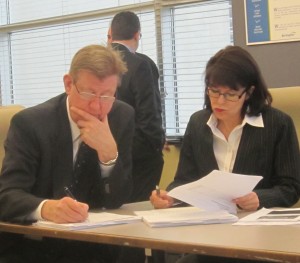 Councillor Sharman and then Director of Transit Donna Shepherd working through a budget document. 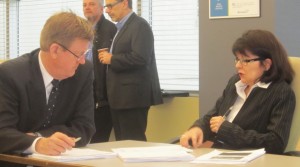 Her body language says it all. Shepherd retired later in the year. At the Committee of the Whole meeting on Monday Councillor Sharman complained of a delegator who eyeballed every member of council in what he felt was a threatening manner before leaving the chamber. Sharman said it was “uncomfortable “.
Dumb behavior is dumb behaviour and it is not to be tolerated. How we manage it is another matter.
During the council meeting on the Task Force Lancaster was proposing Councillor Sharman spoke frequently about misinformation and seemed to be suggesting that what was going on in Nazi Germany during WWII may be now taking place in Burlington; propaganda and misinformation. The Councillor is watching too much television.
 This citizen was unhappy about transit service. At the time the city was doing nothing about transitr until a new staff member did an analysis of some data and told the city manager there were serious problems. The citizens had been right for some time – but they weren’t listened to.  A parent who didn’t want the high school his child was attending closed. As I listened to the debate via the web cast there was never any sense that the harassment council members are getting is something they take any responsibility for – the public is upset, very upset. They don’t like what they see their council doing to them and when they find that their delegations are not being heard they react.
Brian Wrixton, the Chair of the Inclusivity Advisory Committee made a very strong point when he said at Committee “there was a lot of educating to be done”.
This council isn’t talking about educating – they are talking about rules they want to see in place to control what happens. Councillor Craven wants to see something in the Procedural bylaw that permits the chair of a meeting to do something with a delegation that is upsetting the members of council. “All a chair can do now” he said “is adjourn the meeting.”
There is some very nasty racist behaviour coming out of the Alton community and that is not to be tolerated. It takes time to erase racist attitudes – ham fisted responses don’t work – never have.
Change gets brought about by leadership – usually from the top. Citizens are finding that they have a city council that just does not want to hear what their concerns are; that their Council has become close to bloody minded in their behaviour. They seem prepared to let the electorate decide if they are doing their job at the election that will take place at the end of October.
With no one coming forward in wards 1, 4 and 5; a possible candidate that might not be much different than what is there now in ward 6, we stand to end up with a council that will be on the wrong end of 4-3 votes.
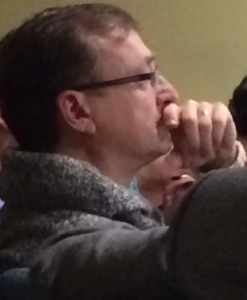 Mike Wallace taking in a city council meeting, wondering perhaps what the Chain of Office will look like on his shoulders. There is more than enough evidence to suggest that the current Mayor is in serious electoral trouble; the question is will the people of Burlington take a leap of faith with Meed Ward or fall back to former city Councillor and Member of Parliament Mike Wallace.
Related articles:
January 30 – 2017 – Clerk gets handed the hot potato issue.
November 16, 2016 – Province begins to nudge the municipalities
November 6, 2015 – Cogeco’s The Issue discuses the lack of a Code of Conduct
July 26, 2015 – New Culture at city hall?
June 2012 Transit director retires
Salt with Pepper are the views, opinions and observations of the publisher of the Burlington Gazette

 By Staff By Staff
February 12th, 2018
BURLINGTON, ON
Automation. The gig economy. Skyrocketing debt. Limitless social connectivity. These are just some of the challenging realities Canadian youth, parents, employers, educators and government face as we help youth and young adults transition into a changing workplace.
 Thursday, March 8, 2018, 7:00 – 8:30 pm at the Burlington Performing Arts Centre Thursday, March 8, 2018, 7:00 – 8:30 pm at the Burlington Performing Arts Centre
Join Burlington Foundation, in partnership with RBC, for a night of timely conversation featuring renowned McMaster educator, author and Top 30 global management guru, Dr. Nick Bontis.
 Nick Bontis teaches at McMaster where his mile a minute delivery dazzles his students. Following his high-energy presentation, Nick will moderate a lively panel discussion with business, government, education and young adults. This vital talk will shine the light on opportunities, obstacles, collaborations and actions we have before us now, and in the future as we help young Canadians achieve personal and professional success. For when young Canadians prosper, business and community do.
Panel members include:
Eleanor McMahon; MPP Burlington, President of the Treasury Board, Minister Responsible for Digital Government
John Romano; Co-founder, Nickel Brook Brewery Co.
David Santi; Dean, Engineering Technology, Mohawk College
Roman Turchyn; Vice President, Human Resources, L3 WESCAM
Erinn Weatherbie; Co-creator of Kelly’s Bake Shoppe & Best-selling Cookbook “Made With Love”
Charlotte Zhen; Analyst, Deloitte Canada, Young Professional
 This is a FREE event open to all, with voluntary non-perishable food donations being collected in support of Burlington Food Bank. This is a FREE event open to all, with voluntary non-perishable food donations being collected in support of Burlington Food Bank.
Register here.

 By Pepper Parr By Pepper Parr
February 1st, 2018
BURLINGTON, ON
Council added more money for transit and sports fields maintenance to the 2018 operating budget after committee deliberations January 18th and approved an operating budget at city council on January 29th that sets the operating budget with a 4.36% increase in the tax to be collected over last year.
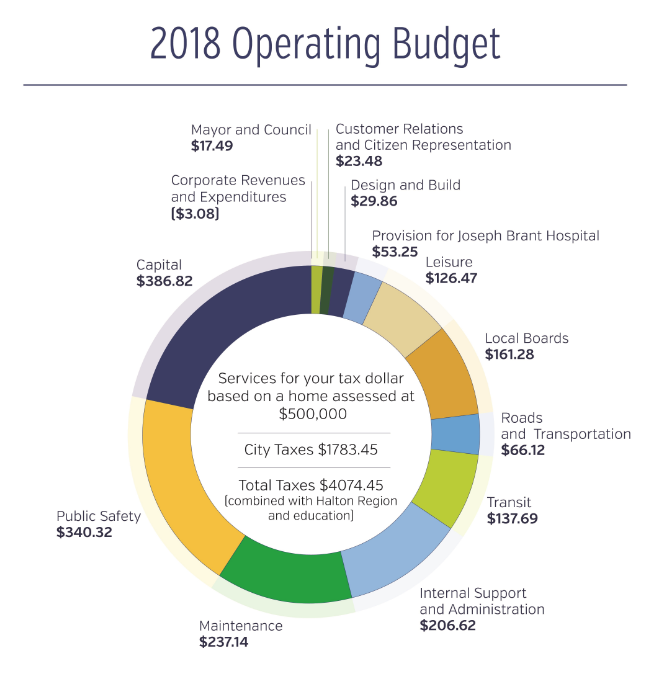 Burlington tax increases have been hovering at the 3 to 4% annual tax increases for much of the two terms the current council has been in office. Burlington tax increases have been hovering at the 3 to 4% annual tax increases for much of the two terms the current council has been in office.
This year the city manager had to deal with three cost increases that they should have seen coming.
The arbitration that gave the fire fighters significant increases.
$1.2 million, or an additional tax increase of 0.78 per cent for impacts from the 2014 arbitrated Fire Department settlement
The provincial decision to set a minimum wage increase.
$1 million, or an additional tax increase of 0.65 per cent for legislative changes to the Employment Standards and Labour Relations Acts (Bill 148)
The need to improve transit service.
$1.55 million, or an additional tax increase of 1.01 per cent for changes made in transit to provide operational sustainability and increased reliability of service
The pressure from these three requirements meant there weren’t going to be any business cases put forward for new services. The departments were told to look for way to cut spending – a 5% tax increase was something that had to be avoided.
The 2018 operating budget focuses on:
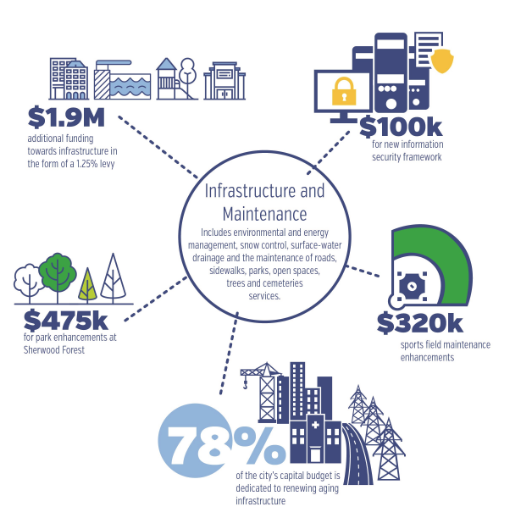 • Investing in infrastructure and maintenance – in accordance with the city’s Asset Management Plan, the dedicated infrastructure levy has been increased by 1.25 per cent or $1.9 million. Of the $160.1 million collected through the tax levy, $34.72 million will fund the capital program and renewing Burlington’s aging infrastructure. • Investing in infrastructure and maintenance – in accordance with the city’s Asset Management Plan, the dedicated infrastructure levy has been increased by 1.25 per cent or $1.9 million. Of the $160.1 million collected through the tax levy, $34.72 million will fund the capital program and renewing Burlington’s aging infrastructure.
• Transit and transportation – strategic investments to improve the city’s transit service, including $1.55 million for changes in transit to provide operational sustainability and to improve reliability of the service.
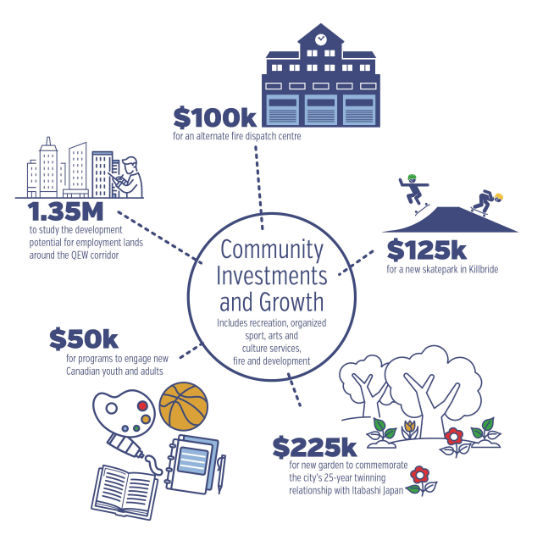 • Community investment and growth – to provide an additional investment of $320,000 to enhance the maintenance of sports fields. • Community investment and growth – to provide an additional investment of $320,000 to enhance the maintenance of sports fields.
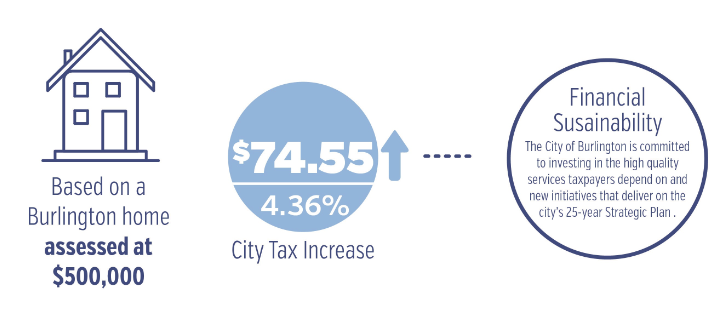 • Financial sustainability – Burlington’s operating budget is committed to ensuring the city has competitive property taxes. Since 2011, overall tax increases in Burlington have averaged 1.9 per cent. In a comparison of property taxes in municipalities in the Greater Toronto and Hamilton Area, Burlington’s property taxes are the third-lowest for a residential single-family detached home. • Financial sustainability – Burlington’s operating budget is committed to ensuring the city has competitive property taxes. Since 2011, overall tax increases in Burlington have averaged 1.9 per cent. In a comparison of property taxes in municipalities in the Greater Toronto and Hamilton Area, Burlington’s property taxes are the third-lowest for a residential single-family detached home.
There is a little creative license blended into that 1.9 % increase. It reflects the Regional and Education taxes – what matters to the people at city hall is how they determine what the city tax rate is going to be.
The increased spending on transit became necessary when a new employee with an MBA began to look at and analyze the transit spending – he discovered a number of serious problems that the city manager realized he had to act on. City hall has not been known for its commitment to transit. The problems that were brought to the surface had to be dealt with immediately.
Not to mention that the council members talk about the public having to learn to use public transit and bicycles but not putting real dollars into transit. That situation has changed.
When Burlington learned that it was going to have to come up with $60 million for the re-development of the hospital city council put a special levy in place which was shown on the tax bill. When that was put in place the indication was that this was just a one-time thing.
Good luck on that one. When the hospital levy has raised all that was needed to cover the $60 million – the levy will stay in place and be directed to bringing the infrastructure up to standard.
Councillor Sharman said at a budget meeting that Burlington went for seven years without a tax increase (that was well before he was elected to office – in his first year as a Councillor he pushed his colleagues into a 0% increase) and that we were now paying for that decision. The infrastructure was not given the resources it needed and it was time to catch up.
City of Burlington property taxes for a home assessed at $500,000 are $1,783.45. When combined with the proposed Halton Region increase and no change for education, overall property taxes for a home assessed at $500,000 are $4,074.45.

 By Staff By Staff
January 3rd, 2018
BURLINGTON, ON
How did the 421 Brant development get to where it is today?
The developer took a proposal to city hall, the planners talked about it and suggestions were made.
Then the Tall Building Guidelines were introduced and the developer found a way to revise a plan and convince the Planning department that it was worth recommending. )See the Muir note on Ridge negotiating)
The letter from the developer to the Planning department set out below shows how the two sides managed to come together.
The visuals used in this article were not provided by the developer – they come from the Burlington Gazette photo data bank and are used to lighten the narrative which can be pretty boring at times.
January 12, 2017,
City of Burlington
Planning and Building Department City Hall
426 Brant Street
P.O. Box 5013
Burlington, Ontario L7R 3Z6
Delivered By Hand
Attention: Mary Lou Tanner, MCIP, RPP
Director of Planning & Building
Dear Ms. Tanner:
Subject: Official Plan & Zoning Amendment Application Redevelopment of 421 – 431 Brant Street & 2007 – 2011 James Street (“421 Brant”)
Northwest Quadrant of Brant Street & James Street City of Burlington
421 Brant St Inc.
421 Brant St Inc., the acting owner of the above noted properties (the “subject land”), is pleased to submit this application to amend the Official Plan for the City of Burlington and Zoning By-law 2020, as amended, to facilitate redevelopment and revitalization within the core of the Downtown area.
 A development project had a lot going for it in the early stages – then the public took notice and said they didn’t want it. Purpose of the Applications:
To permit the redevelopment of the subject land to allow high density mixed-use redevelopment within the Downtown core of the City of Burlington, official plan and zoning amendments are required.
Description of the Subject Land:
The subject land is located within the northeast quadrant of the intersection of Brant Street and James Street, immediately across the street from Burlington’s City Hall. Comprised of a total site area of approximately 0.20 hectares, the subject land fronts onto Brant Street, James Street and John Street. Several commercial buildings and operations currently exist or have existed on the subject land since the 1950’s. The subject land is
significantly under-developed for a site that is ultimately one of the most prominent and significant redevelopment sites in the Downtown area of the City of Burlington.
Project History:
421 Brant St Inc. has been assembling these lands for several years and has considered many possible redevelopment scenarios over this time. More recently, Brant St Inc. has been working with its consultant team to formalize its redevelopment proposal and bring it forward for approval. The project team includes:
Fothergill Planning and Development Inc.;
Turner Fleischer Architects Inc.;
Bousfields;
Ferris+Associates Inc.;
S. Llewellyn and Associates;
Novus Environmental Inc.;
Paradigm Transportation Solutions Inc.;
Terraprobe Inc.; and,
AT. McLaren Limited.
Prior to submitting the requisite development applications to the City of Burlington, 421 Brant St Inc. presented a proposal to the City as part of the standard pre-submission consultation process. This proposal is generally summarized as follows:
Original Proposal:
The original proposal was designed in the absence of contemporary development standards for Burlington’s Downtown and specifically to consider expectations of the market.
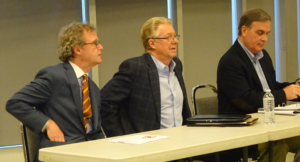 The 421 Brant project got a more than favorable response at the first public meeting. Two private sector planners and a Carriage Gate executive. The original proposal included:
• Approximately 23,226 sq. m. of total gross floor area within a 25 storey building – representing a floor area ratio of 11.71;
• A tower floor plate size of approximately 870 sq. metres;
• Approximately 195 residential units and parking at a rate of approximately 1.1 spaces per unit and 0.1 spaces for non-residential uses respectively;
• A three storey podium with retail at grade, office space on the second floor and residential units on the third floor;
• Podium setbacks from the edge of street pavement as follows: Brant Street – approximately 4 metres; James Street – approximately 3.9 metres; and, John Street – approximately 4.5 metres;
• Promoted a strong streetscape as a result of the positive relations created by the massing of the podium and the width of the setbacks/streetscape provided;
• Tower setback from northerly property line – Minimum 12.5 metres;
• The condominium entrance and lobby area was proposed at the south corner of the site; and,
• Loading, service bays and underground parking ramps accessing John Street.
As this concept was being finalized by Turner Fleischer, the City of Burlington released new draft city-wide guidelines for tall buildings in the City of Burlington in August 2016. Tall Buildings Guidelines were approved by City Council on September 13, 2016 as interim (the “guidelines”). These guidelines include critera that are new to the City of Burlington and had not been previously implemented in most high rise developments in the City.
Through our pre-submission consultation meeting with City staff, we were advised of the City’s intent to implement the “guidelines”. In light of this dramatic change in philosophy and approach towards tall buildings and to respond to other comments received from City staff (as noted in the minutes from the pre-submission consultation meeting), 421 Brant St Inc. went back to the drawing board with its project team to investigate ways in which the new guidelines could be addressed while at the same time addressing market expectations and the economic feasibility of the project.
Further to significant additional analysis by the project team and 421 Brant St Inc., the redevelopment proposal has been significantly revised. The revisions that have been made demonstrate the will and desire of 421 Brant St Inc. to cooperate with City staff and Council to bring this project to market as quickly as possible. The revised proposal is summarized as follows:
Revised Proposal (“421 Brant”):
 Nick Carnicelli Dramatic modifications have been made to the project to promote compliance with development standards included in the guidelines and to respond to comments received from City staff:
• The FAR has been reduced from 11.71 to 11.24;
• To accommodate wider streetscapes around the project, as requested by City staff, the podium setbacks from the edge of street pavement have been increased as follows: Brant Street – from approximately 4 metres to approximately 6 metres; James Street – from approximately 3.9 metres to approximately 6.08 metres; and, from approximately 4.5 metres to approximately 5.87 metres on John Street.
• While the increased podium setback accommodate a significantly wider streetscape/pedestrian realm and may be visually attractive, this has resulted in the elimination of a significant amount (over 300 sq. m.) of valuable retail and office floor space;
• A three storey podium;
• Tower floor plate – reduced from 870 sq. metres to 799 sq. metres;
• Residential units sizes and dimensions have been significantly modified;
• In response to the Interim Tall Buildings Guidelines, the height of the development has been revised from 25 to 26 floors;
• In response to the modifications noted above, the total residential unit count has been reduced from 195 to 183;
• To improve and reinforce the relationship of the proposed re-development to the street and the civic open space adjacent to City Hall, a substantial cut-out has been made to the southwest corner of the building at the Brant Street and James Street intersection;
• To reinforce the significance of James Street, the entrance to and lobby of the residential component of the development has been relocated such that the main entrance is located “mid-block”; and,
• In response to City comments in respect of the visual prominence of the loading and service entrance on John Street, overhead doors have been included to screen these operational functions.
Impact of Proposed Modifications:
a) Satisfies the intent of the Official Plan and builds upon the evolving planning policy framework for the Downtown and the mobility hub;
b) General compliance with Interim Tall Buildings Guidelines;
c) Superior streetscape and relationship of the building to the public realm – promoting animation and vitality on the streets;
d) Building height and floor area ratio are suitable and appropriate for this landmark location located at a gateway to City Hall;
e) Improved relationship between the project to civic open space at both the north and south ends of City Hall;
f) No adverse wind, noise, sun light penetration or shadow impacts;
g) Enhanced access to residential condominium from the middle of the block along James Street – promotes and enhances the prominence of James Street;
h) Improved entrance to the office space from Brant Street;
i) Effective screening of loading and service facilities and functions on John Street;
j) New retail space at the corner of James and John Streets provides new and improved options for retailers and enhances the economic vitality of the area as one moves east from Brant Street;
k) Frames and compliments the view of City Hall from most directions;
I) To assist the City in its efforts to minimize the use of private motor vehicles and promote TOM standards and the use of public transit, reduced parking rates are to be implemented;
m) The underground parking garage that satisfies all City design standards;
n) Improved outdoor amenity space promoting interaction with Brant Street at multiple levels;
o) Promotes the revitalization of the Downtown Core;
p) The proposed redevelopment is compatible with neighbouring uses and activities;
q) The building architecture has been refined;
r) Mixed-use building setting a new standard for the Downtown while expanding the City’s tax base; and,
s) To improve and reinforce the relationship of the proposed re-development to the street and the civic open space adjacent to City Hall, a substantial cut-out has been made to the southwest.
Existing Planning Permissions and Amendments Required: Official Plan for the Regional Municipality of Halton:
The Official Plan for the Regional Municipality of Halton designates the subject property as being located within an “Urban Area” within the “Urban Growth Area”. This permits a range of urban uses which are to be designated in accordance with local official plans and zoning by-law. The proposal, as described, satisfies objectives for Urban Growth Centres in the Region and helps to achieve policies in the Plan promoting redevelopment and intensification of Urban Areas, and is in conformity with the Regional Official Plan. No amendments are required.
The Official Plan for the City of Burlington:
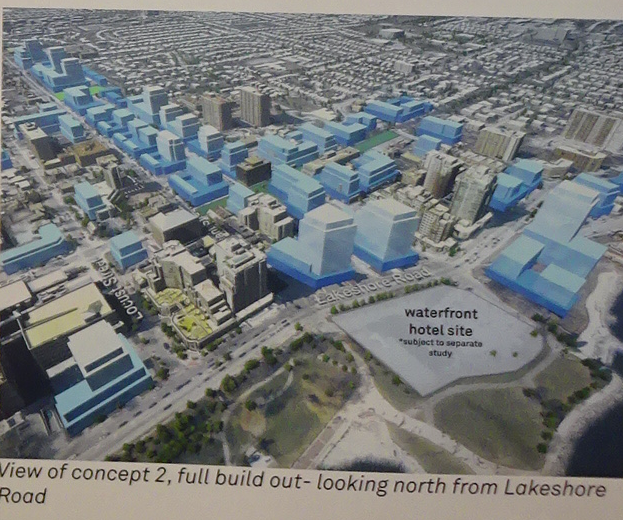 A visual of one of the concepts shown at a city sponsored public meeting. Official plan policies promote and encourage the form of redevelopment that is being proposed, which achieves stated policies with respect to infill and housing intensification. At the same time, the policies are clear that consideration must be given to the issue of compatibility with existing neighbourhoods and surrounding development. The extent to which the proposal can achieve these objectives is considered in more detail in the Planning Justification Report prepared by Fothergill Planning and Development Inc. and the Urban Design Brief prepared by Bousfields.
While the proposal meets the general intent of the direction of the Official Plan, there are specific policy provisions that are required to be amended in respect of building height and permitted floor area ratio.
It must also be noted that the City of Burlington has commenced the process of undertaking a comprehensive review its Official Plan. This exercise recognizes that Downtown Burlington is one of the key areas within the City which can, and should, accommodate significant redevelopment and intensification initiatives. It is our understanding that the redevelopment proposed is consistent with the policy directions currently being considered by the City of Burlington. Therefore, the proposed amendments to the Official Plan appear to be representative of the policy framework being developed and as such do not challenge the overlying goals and objectives being promoted.
Interim Tall Buildings Guidelines:
The City of Burlington has also confirmed its new direction to promote “tall buildings” through its adoption and implementation of “Interim Tall Buildings Guidelines”. While it is recognized that these are guidelines, City Council has demonstrated its support for new development and redevelopment that satisfies these guidelines and further that these guidelines are in conformity with and are intended to reinforce and implement official plan policies for the Downtown in particular.
Zoning By-law 2020, as amended:
Zoning By-law 2020, as amended, zones the subject land DC (Downtown Core) and DC- 434 (Downtown Core – Modified). This zoning permits a mix and range of uses including an apartment building, retirement home, offices, restaurants and retail units. Special Exception Number 434 allows for a maximum height of 17 storeys and 21 metres as opposed to the standard requirement of 4 storeys and 15 metres in a DC zone and a floor area ratio of 4.5:1 as opposed to the 4:0:1 permitted in a DC zone. A zoning amendment is required to implement the Interim Tall Buildings Guidelines and the proposed redevelopment.
Conclusions:
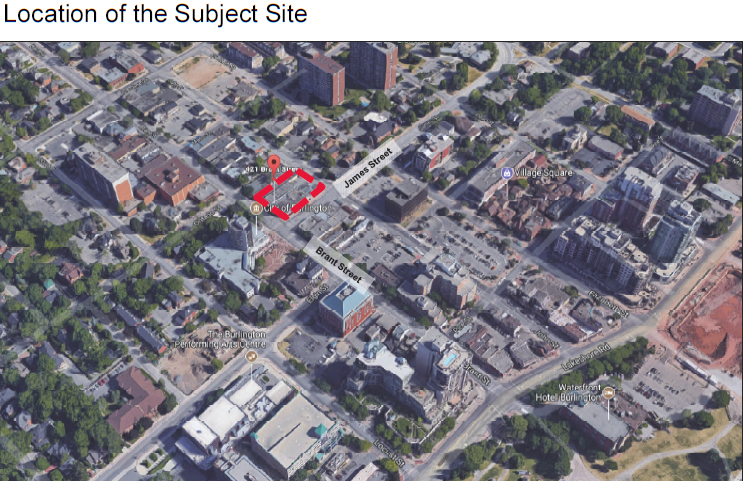 Aerial of 421 site 421 Brant St Inc. has made significant revisions to its redevelopment proposal to accommodate comments received from the City of Burlington and we are of the opinion that the proposed redevelopment represents good planning and satisfies the intent of all Provincial, Regional and City policies and guidelines while effectively promoting the evolving planning regime pursued by the City of Burlington for its Downtown Core.
Included with this Submission:
• Application fees;
• Application form;
• Architectural site plan drawings, prepared by Turner Fleischer;
• Shadow Analysis, prepared by Turner Fleischer;
• 3d model, prepared by Turner Fleischer;
• Waste Management Plan, prepared by Turner Fleischer;
• Planning Justification Report, prepared by Fothergill Planning and Development Inc.;
• Urban Design Brief, prepared by Bousfields;
• Transportation Impact Study, Parking Study and TOM Options Report, prepared by Paradigm Transportation Solutions Inc.;
• Conceptual Landscape drawings, prepared by Ferris+Associates;
• Pedestrian Wind Assessment, prepared by Novus Environmental Inc.;
• Environmental Noise Assessment , prepared by Novus Environmental Inc.;
• Functional Servicing Report, prepared by S. Llewellyn and Associates;
• Phase 1 Environmental Report, prepared by Terraprobe Inc.;
• Environmental Screening Checklist, completed by 421 Brant ST Inc.;
• Geotechnical Engineering Report, prepared by Terraprobe Inc.; and,
• Boundary and topographic survey, prepared by A.T. McLaren.
We look forward to working with the City of Burlington on this project.
Should you have any questions, please do not hesitate to contact the undersigned.
Yours truly,
421 Brant St Inc.
Comparing the changes that were made between the original proposal and the final submission shows the degree to which the developer was prepared to accommodate the requests from the planners.
What no one saw coming at the time was the public reaction to a 5-2 city council vote approving the project.
Related Gazette content:
Muir and Ridge talk about negotiated developments.

 By Staff By Staff
January 2, 2018
BURLINGTON, ON
The announcement from city hall was pretty straight forward – the review of city’s proposed 2018 operating budget will take place January 18.
Then the kicker – Proposed city tax increase of 4.19%
How much longer can Burlington smack the tax payers with property tax increases of more than 4%.
It just isn’t sustainable.
The 2018 operating budget delivers a base budget to maintain city service levels.
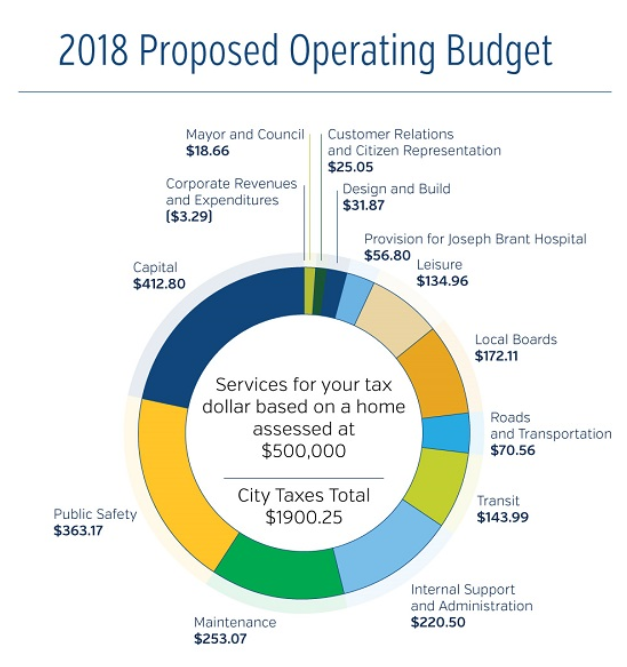 Other impacts to the 2018 operating budget include: Other impacts to the 2018 operating budget include:
• $1.9 million or an additional tax increase of 1.25 per cent dedicated to the renewal of city infrastructure as outlined in the Asset Management Plan.
• $1 million or an additional tax increase of 0.65 per cent for legislative changes to the Employment Standards and Labour Relations Acts (Bill 148) including increases to minimum wage.
• $1.3 million or an additional tax increase of 0.84 per cent for changes in transit to provide operational sustainability.
• $1.2 million or an additional tax increase of 0.78 per cent for impacts from the 2014 arbitrated Fire settlement.
• $320,000 or an additional tax increase of 0.21 per cent to enhance maintenance standards on city sports fields.
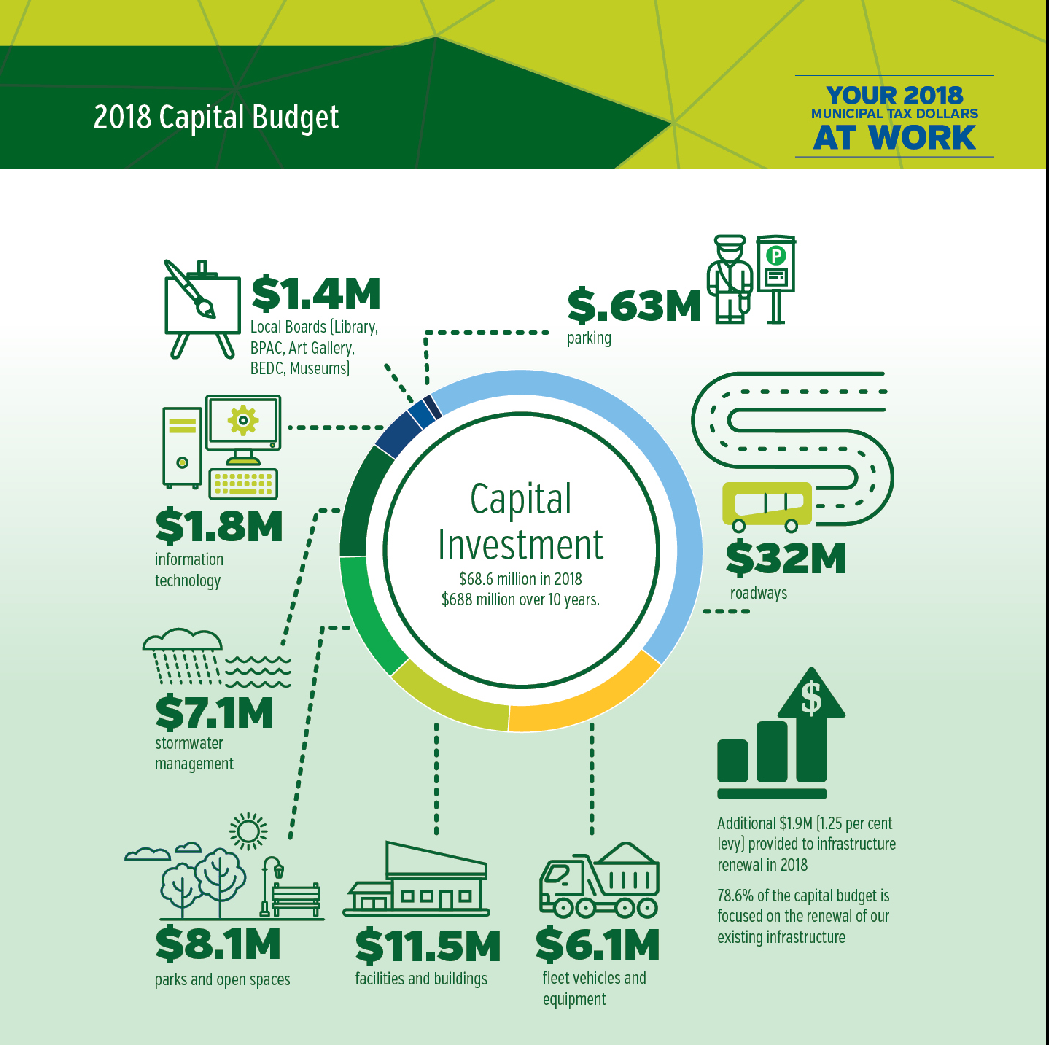 The total city tax increase in the proposed 2018 operating budget is 4.19 per cent. When combined with Halton Region’s proposed tax increase and no change for education, the overall tax increase is projected at 2.49 per cent or $21.03 per $100,000 of Current Value Assessment. The total city tax increase in the proposed 2018 operating budget is 4.19 per cent. When combined with Halton Region’s proposed tax increase and no change for education, the overall tax increase is projected at 2.49 per cent or $21.03 per $100,000 of Current Value Assessment.
There is an ongoing fallacy that gets trotted out each year by Joan Ford, Director of Finance: “Despite a number of significant budget pressures like the increase to Ontario’s minimum wage effective Jan. 1, 2018, and funding needed to address operational challenges in transit, Burlington’s proposed operating budget continues to ensure our assets are renewed and maintained in a fiscally responsible manner. Since 2011, overall tax increases in Burlington have averaged 1.9 per cent. In a comparison of property taxes in municipalities in the Great Toronto Hamilton Area, Burlington’s property taxes are the third lowest for a residential single-family detached home.”
Every word of that is true – however neither Burlington’s finance department nor its city council can do a blessed thing about the demands the school board or the Region make on the pocket books of the tax payers: Burlington is asking for an increase of 4.19% – they have been asking for more than, or very, very close to 4% for the past four years.
 Ward 5 Councillor Paul Sharman was tough enough in 2010 to keep the tax increase to 0. There was a time, back in 2010, when the tax increase was zero! Councillor Sharman was the driving force behind that effort. Council did it once – they should be able to do it again. It’s called belt tightening.
Members of the public who would like to speak at the Committee of the Whole budget meeting as a delegation can register by calling 905-335-7600, ext. 7481 or visiting burlington.ca/delegation. The deadline to register as a delegation for the Jan. 18 meeting is noon on Jan. 17, 2018.
Council approval of the proposed 2018 operating budget is scheduled for Monday, January 22, at 6:30 p.m.

 By Staff By Staff
December 7th, 2017
BURLINGTON, ON
The City of Burlington announces that effective December 21, 2017; Mary Lou Tanner will assume the position of Deputy City Manager. Tanner was the successful candidate after a comprehensive internal competition.
Tanner is currently the Chief Planner and Director of the Department of City Building for the City of Burlington. Tanner has been with the city since November 2015 heading the department responsible for planning, building, by-law and culture.
 Mary Lou Tanner will assume the position of Deputy City Manager. Tanner is a well-recognized and experienced leader in municipal planning and development and is a Past President of the Ontario Professional Planners Institute and a graduate of the Planning School at Queen’s University.
The Deputy City Manager role is a new position at the City of Burlington which will report to City Manager James Ridge.
Key responsibilities of the Deputy City Manager include:
• Serve as the city’s representative for all Agencies, Boards and Commissions; acting in an advisory and liaison capacity for each organization and helping plan and coordinate major capital projects.
• Being responsible for the diversity and inclusivity portfolio; ensuring a strategy is developed, and implemented across the organization for all services and programs;
• Overseeing the Project Management Office, ensuring the priorities of this office are aligned with the Strategic Plan and corporate work plans and work with the Senior Leadership team to identify and establish priorities across the organization.
A transition plan including an acting Director of City Building will be announced in the near future; however in the meantime Tanner will continue to lead the work on the completion of the city’s new Official Plan.
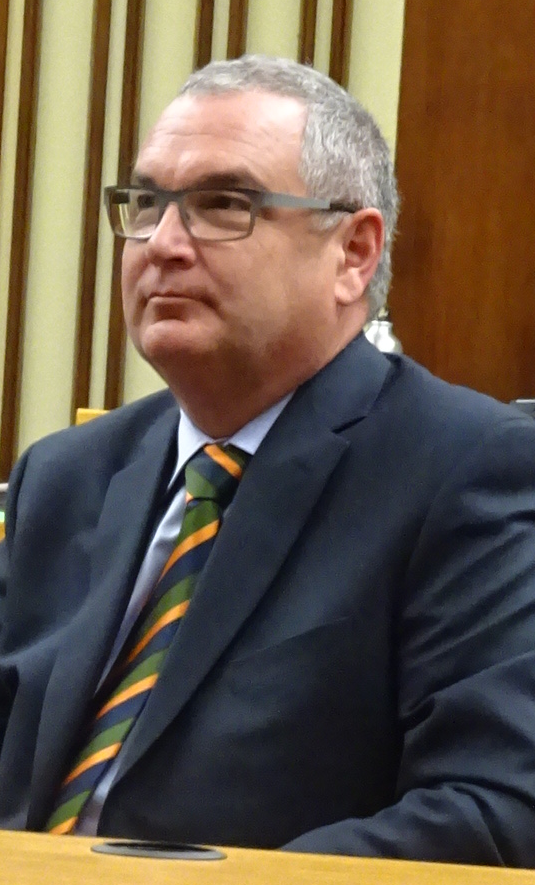 James Ridge on his first council meeting as city manager. Prior to city manager James Ridge being appointed Burlington had three General Managers. One was shown the door, another retired and a third Scott Stewart took a position as deputy city manager in Guelph. Stewart was a candidate for the city manager position.
Ridge has been running the city with his office being the report to point for all the Directors.
Sometime will be needed to think through just what this small level or re-organization is going to mean to the citizens of the city.

 By Pepper Parr By Pepper Parr
December 3rd, 2017
BURLINGTON, ON
Budget time.
City staff presented an Operating budget with a 4.19 % increase over last year – this will be the xx year that tax payers have seen increases in the 4% range.
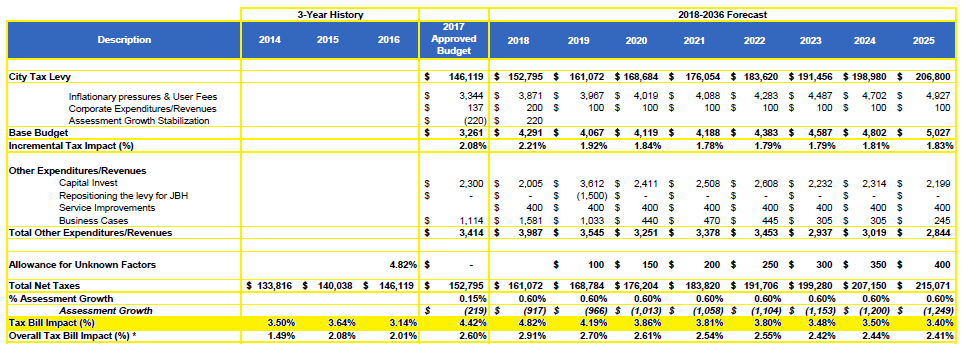 The disturbing part of this budget is the prediction going forward for increases that are wll above inflation at a time when the economy is very healthy. The line that is solid yellow is the one that tax ayers need to focus on The proposed net tax levy for the 2018 fiscal year for the Operating budget will amount to $159,855,656. Staff propose that Council approve this amount on January 22, 2018.
Staff did a line-by-line review of the base budget and found $600,000 in savings.
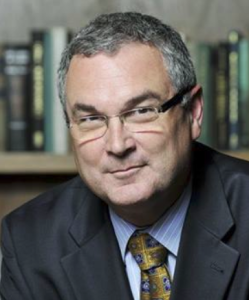 City manager James Ridge. The strategic review of the Operating Budget is done by a Leadership Team comprised of the City Manager, Director of Finance, Director of Human Resources. The Director of Planning and Building and the City Clerk took part as rotating member.
The following were events that impacted the Operating budget:
The estimated impact from legislative changes to the Employment Standards and Labour Relations Acts (Bill 148) of $1 million results in an additional tax increase
The annualized impact of changes made within the Transit Service to provide operational sustainability of $1.3 million results in an additional tax increase
Impacts from the 2014 arbitrated Fire settlement of $1.2 million results in an additional tax increase
The increase for the dedicated infrastructure levy of $1.9 million results in an additional tax increase
A business case to increase maintenance standards on city sports fields for $320K
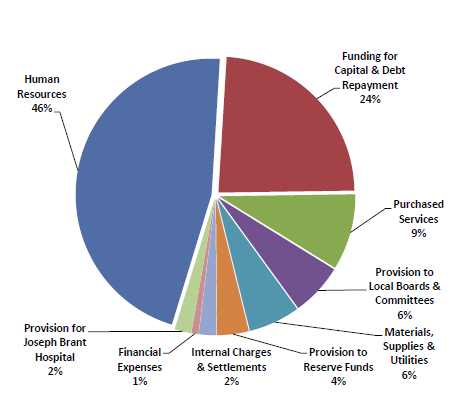 Where the money gets spent These events plus the base budget already in place result in a total tax increase to 4.19%.
The following table provides a breakdown of the city’s tax increase.
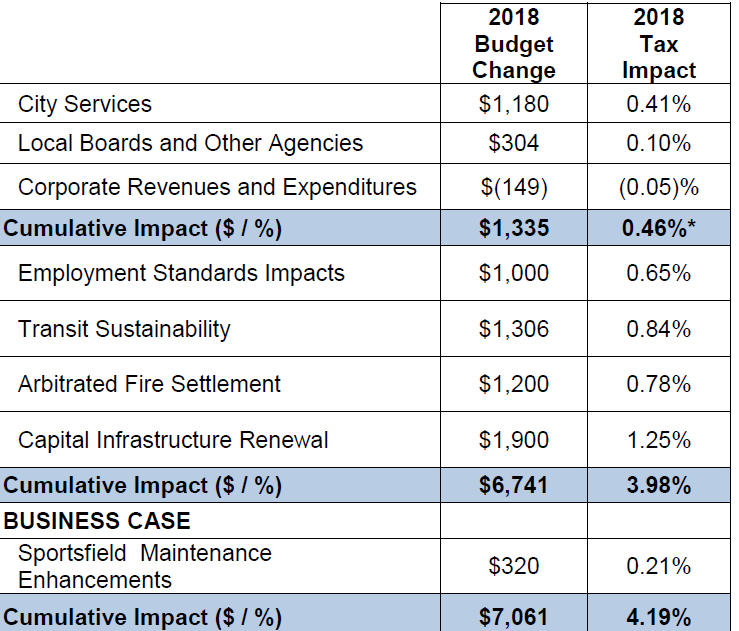 The cost increases put upward pressure on the budget; more money going out. The lower than anticipated assessment growth meant less money coming in. The difference between those two numbers is found in the pockets of the tax payers. The cost increases put upward pressure on the budget; more money going out. The lower than anticipated assessment growth meant less money coming in. The difference between those two numbers is found in the pockets of the tax payers.
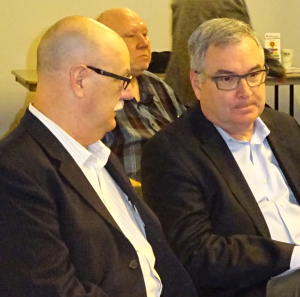 Former Director of Transit Mike Spicer sitting with city manager James Ridge – the facial expressions tell the story. Spicer resigned several months later. Council learned on September 7, of the “challenges facing the department’s operations”. Those challenges are going to add s approximately $1.3 M to the proposed 2018 budget.
Municipalities are service organizations that rely heavily on human resources to deliver the range and quality of services that residents have come to expect. Human resource costs (including benefits, training, etc.) as a percentage of the City’s gross budget has changed from 50.5% in 2004 to 46.2% proposed for 2018.
Local Boards include the Burlington Public Library, Burlington Museums, Art Gallery of Burlington, Burlington Performing Arts Centre (BPAC), Tourism Burlington and the Burlington Economic Development Corporation (BEDC). For 2018 a base budget increase of 2.0% was provided for local boards, equating to $295,910.
The city continues to make good progress on its infrastructure renewal needs as Council has provided Predictable Infrastructure Investment, in the form of a dedicated incremental infrastructure levy. The proposed budget includes a 1.25% ($1.9 million) levy as recommended in the city’s Asset Management Financing Plan.
A recent review of the Vehicle Depreciation Reserve Fund (VDRF) recommended that the annual contributions to the reserve fund be increased from 3% to 4% per annum to ensure long-term financial sustainability. This increased contribution has an incremental $32,000 ongoing impact to the operating budget.
The city revenues in 2018 will, in part come from the following increases:
• increase in registration fee and rental revenues of $181,000 to reflect increased volume of participants as well as increases to fees
• increase in Building Permit fees of $186,000 to reflect an increase in the costs to administer enforcement of the Building Code (Bill 124)
• increase in Development Application and Approval Processing (DAAP) fees of
$140,000 to reflect an increase in volume and a 2% increase in fees
• increase in parking fines of $215,000 and daily parking revenues of $150,000 to better align with historical revenue trends
• increase in Transit advertising revenues of $170,000 as a result of a new advertising contract.
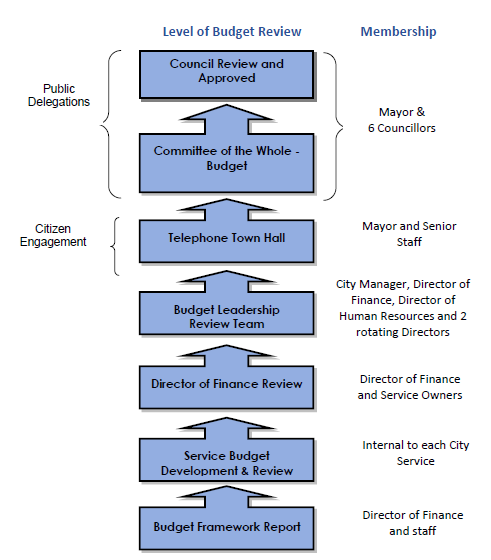 The process for putting a city budget together. A tax bill doesn’t always translate into cash in the city coffers. The city budgets annually for tax write-offs based on assessment reductions or property class changes agreed to by MPAC and/or the Assessment Review Board (ARB).
Annual write-offs have traditionally been approximately $1 million. In 2017 write-offs are estimated to total $2 million due to continued processing of longstanding appeals being resolved by the ARB. These write-offs have depleted the allowance account which will require a provision to be made at year-end as part of the retained savings. The budget for write-offs has been increased by $50,000 to $1.175 million.
These growth costs and other inflationary increases have been offset by assessment growth which allows a municipality to finance increased costs without increasing taxes.
Over the past five years Burlington’s weighted assessment growth was:
2013 0.87%
2014 0.58%
2015 0.97%
2016 1.16%
2017 0.15%
Staff continue to believe a portion of this is one-time in nature.
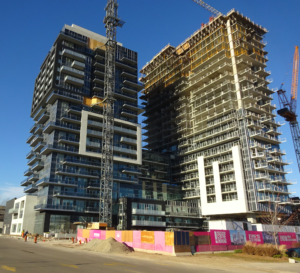 The first of the five tower Paradigm on Fairview will begin to be occupied in 2018 – adding to the tax roles. There are three major projects under construction that will be at least partially completed in 2018 – with people moving in – tax get levied and assessment growth improves.
The 2017 Approved Budget included $200,000 to implement the first phase of the Enhanced Sportsfield Maintenance Strategy. Included with the 2018 budget is a business case to provide the remaining funding requirements of $320,320 and 3.2 FTE to fully implement this strategy. This business case aligns with the city’s Strategic Direction of a Healthy and Greener City. It will result in improved turf resilience and playability as well as demonstrates environmental leadership and stewardship of our natural assets.
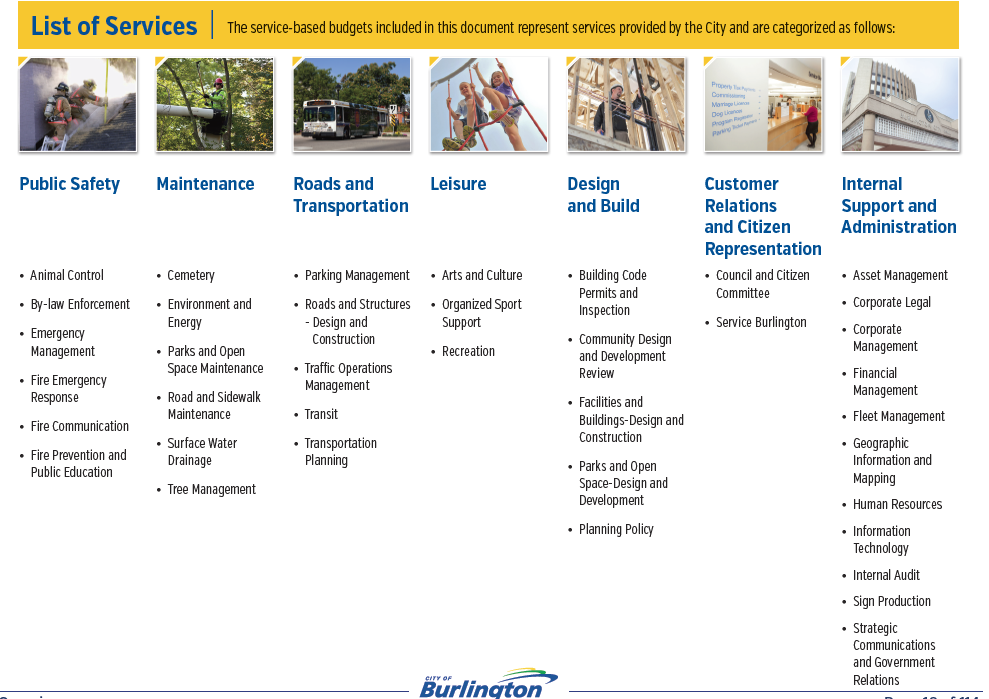 Services the city provides. The proposed city increase of 4.19%, for urban residential taxpayers translates into a tax increase of $21.03 for each $100,000 of residential assessment.

 By Staff By Staff
October 24th, 2017
BURLINGTON, ON
Where does all the money come from?
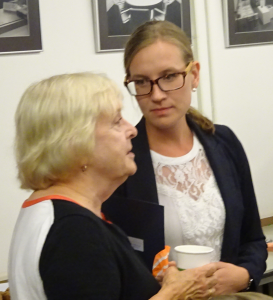 Burlington MP Karina Gould with a constituent. The federal government is pumping a lot of money into Burlington – which means our Member of Parliament is doing her job.
A new list of transit projects has been approved under the Canada-Ontario Public Transit Infrastructure Fund (PTIF) agreement, which is designed to address key infrastructure priorities with a focus on repairing and upgrading existing facilities and assets.
The Government of Canada is providing Ontario with over $1.48 billion under PTIF, and will fund up to 50 per cent of the eligible project costs.
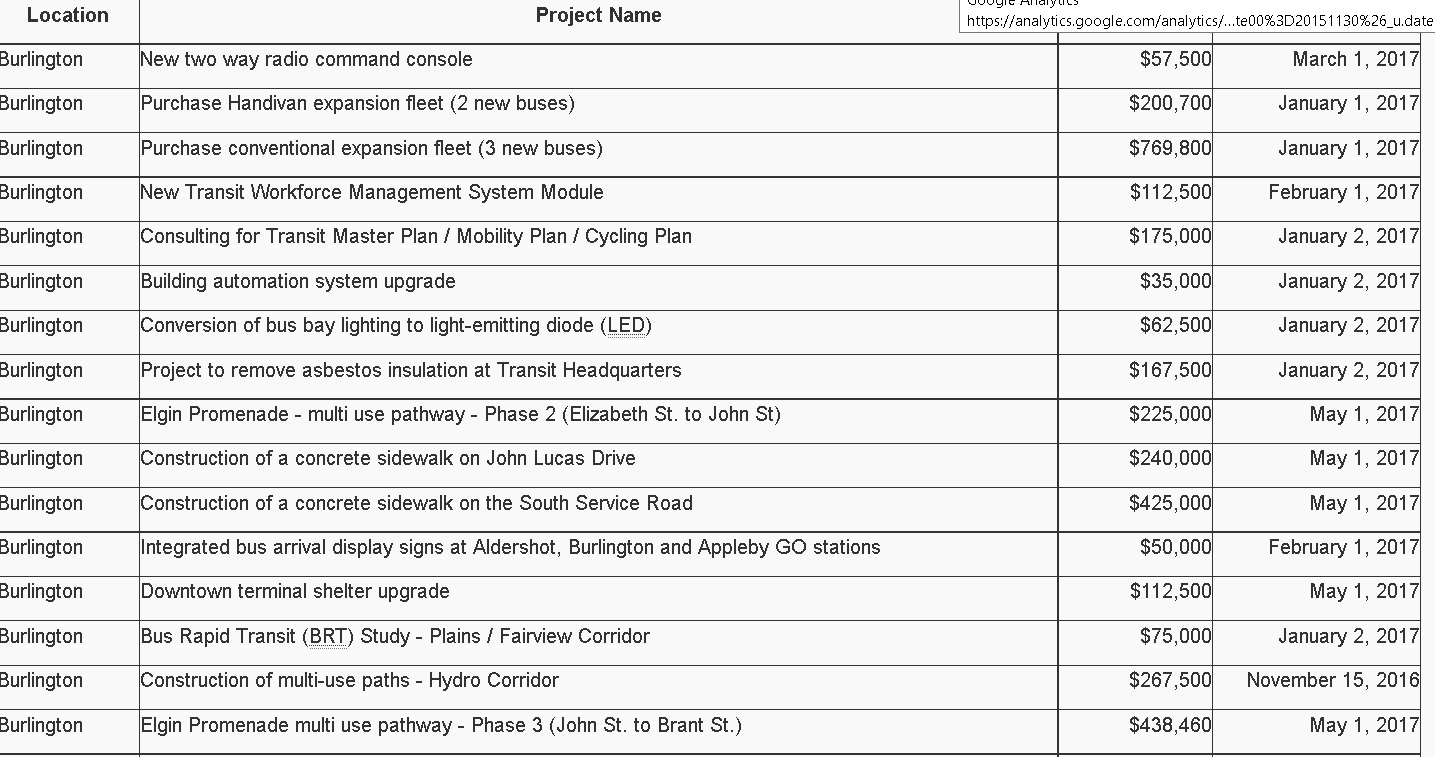 $75,000 for a Bus Rapid Transit on Plains Road – Fairview – where does that fit in? As part of the bilateral agreement with Ontario, the following projects in 28 municipalities have now been approved for federal funding amounting to more than $202 million.

 By Staff By Staff
October 16th, 2017
BURLINGTON, ON
The Burlington Foundation shared the 2017 Vital Signs report last week.
The document is issued every two years and is seen as an important road map for where we are as a community and where the community can work together to make change happen in the areas of youth and young adults, mental health and wellness, housing, the environment and seniors.
Highlights from Vital Signs® 2017 Report part one:
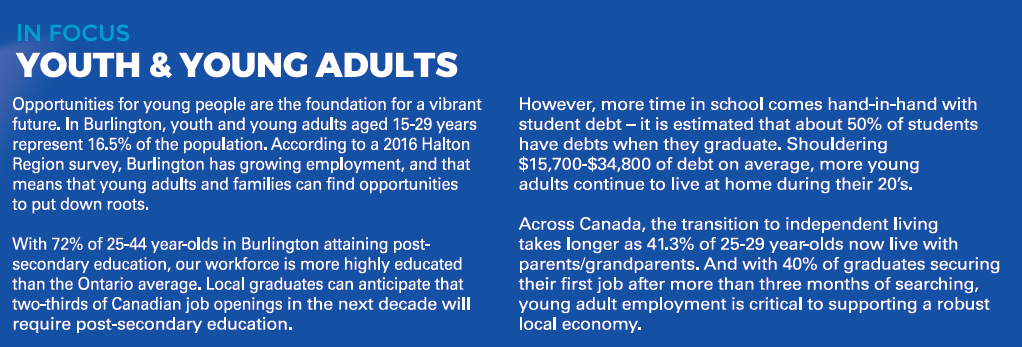
• Connecting young people with opportunities is at the heart of building a strong and sustainable social fabric within the community. In Burlington, 16.5 per cent of the population is aged 15 to 29 years.
• Vital Signs finds that Burlington’s workforce is more highly educated than the Ontario average. Of those aged 25 to 44, 72 per cent have a post-secondary college or university education. This is good news as trends indicate that two-thirds of Canadian job openings in the coming decade will typically require post-secondary education or be in management occupations.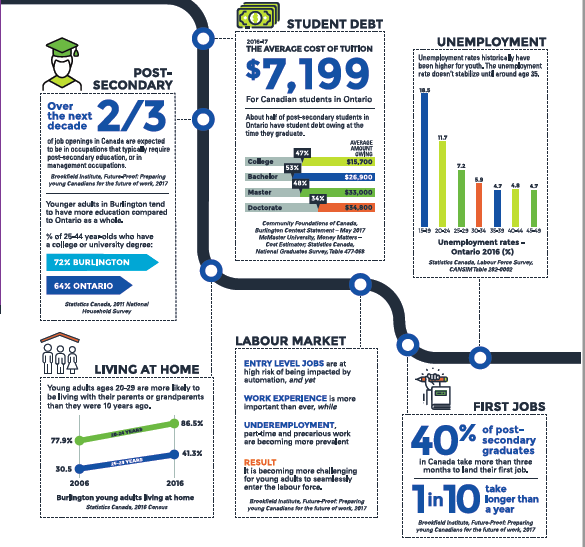

• The number of reportable mental health-related occurrences was 1,656 in 2011 and rose to 3,102 as of 2016. This means Halton Regional Police have experienced a startling 87 per cent increase in mental health-related occurrences involving police.
• In 2016-2017, Joseph Brant Hospital’s Emergency Department had a total of 2,156 visits, an increase of 15% over 2011-2012, and 302 visits among those less than 18 years of age, which represent a 63 per cent increase over 2011-2012.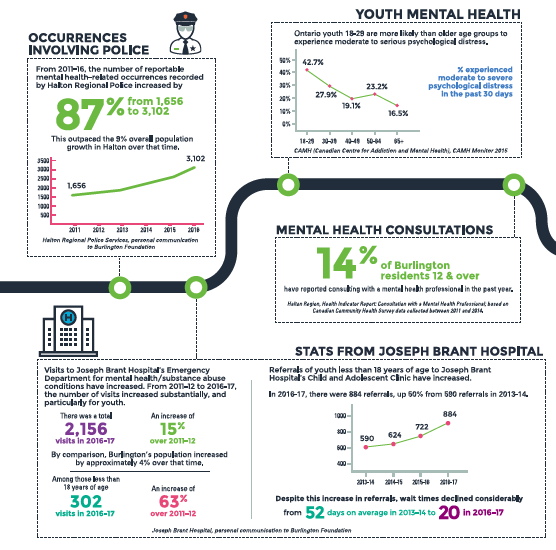
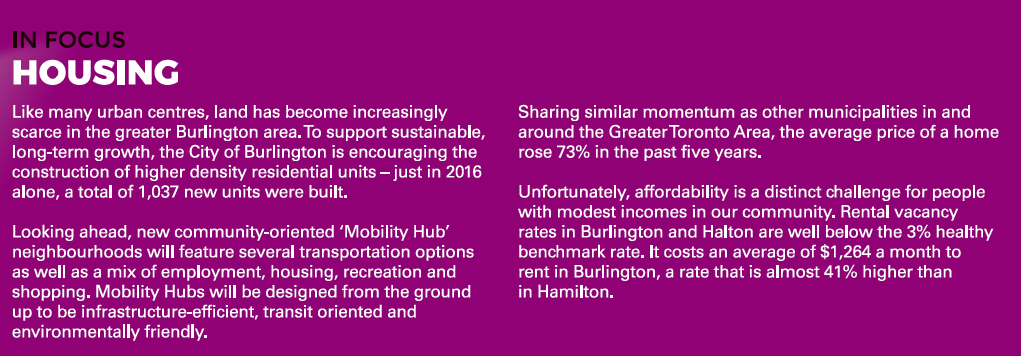
• Average housing prices rose from $454,627 in 2012 to $785,851 as of June 2017 – a staggering 73 per cent increase.
• 51.5 per cent of Burlingtonians live in single detached homes, 23.2 per cent in row houses or semis and 25.3 per cent live in apartments.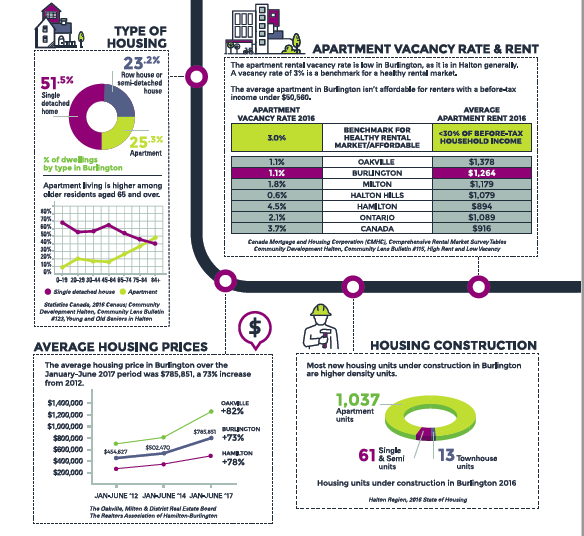

• Halton Region is excelling at waste diversion – in 2015 alone, almost 57 per cent of the region’s waste from landfills was diverted. Efforts to reduce, reuse and recycle have led Halton to be ranked tenth amongst 243 Ontario locations.
• Local waters are cleaner. Hamilton Harbour has benefited from aquatic health improvements as well as improved water bird habitats. Vegetation has returned to Cootes Paradise Marsh and a multi-year habitat restoration project is being led by BurlingtonGreen in Beachway Park.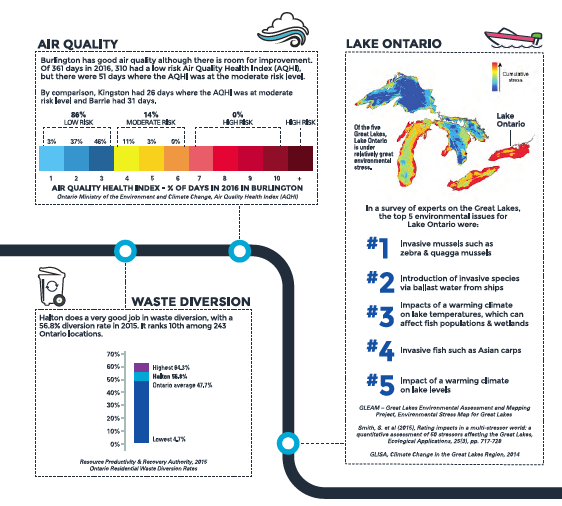

• Burlington’s senior population is growing – so much so that seniors are now our single fastest growing demographic. In the past five years alone, Burlington has seen a 18.9 per cent growth in our senior population compared to just a 1.3 per cent increase among those younger than 65.
• The wait list for long-term care housing is on the rise. Since 2013, wait lists have increased by more than 20 per cent. This means that right now, 2,616 people are on the wait list for one of 1,279 spaces. On average, only 32 spaces become available each month.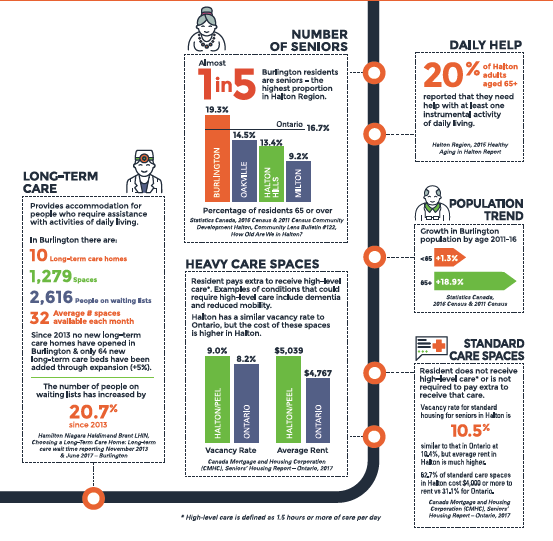
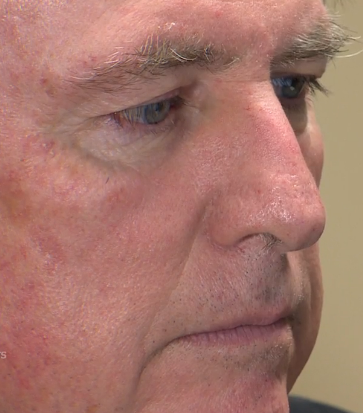 Ron Foxcroft, Chair of the Burlington Foundation. “Vital Signs serves two significant purposes,” says Ron Foxcroft, chair of the Burlington Foundation Board of Directors. “First, it enables Burlington Foundation to focus our leadership efforts and granting program on the most critical areas of need. Second, it’s a valuable reference tool for other local stakeholders to connect the dots between people, numbers and opportunity.”
“Vital Signs is about connecting people to numbers in ways that foster new understanding,” says Colleen Mulholland, President and CEO, Burlington Foundation. “As a community convener, the report helps guide us in our leadership role where we encourage conversation and support collaboration around pressing issues. Whether it’s championing access to mental wellness programs which continues to be a focus for us, helping seniors live more independently, or helping young people transition to the workplace ensuring a greater sense of belonging to community, we’re connecting opportunity to action.”
Due to the release schedule of the 2016 long form Census data, Vital Signs will be published in two parts. In early 2018 the Foundation will share the latest local information about Poverty, Transportation, Work, Newcomers and Inclusivity.
As part of its commitment to incorporate learnings from the Vital Signs Report, Burlington Foundation announced a one-year partnership with Royal Bank of Canada that focuses on supporting youth and young adults as they transition into the workforce. This one-year commitment will focus on bringing together leaders from diverse sectors, as well as young adults, to engage in dialogue and address the opportunities and obstacles youth face as they seek employment.
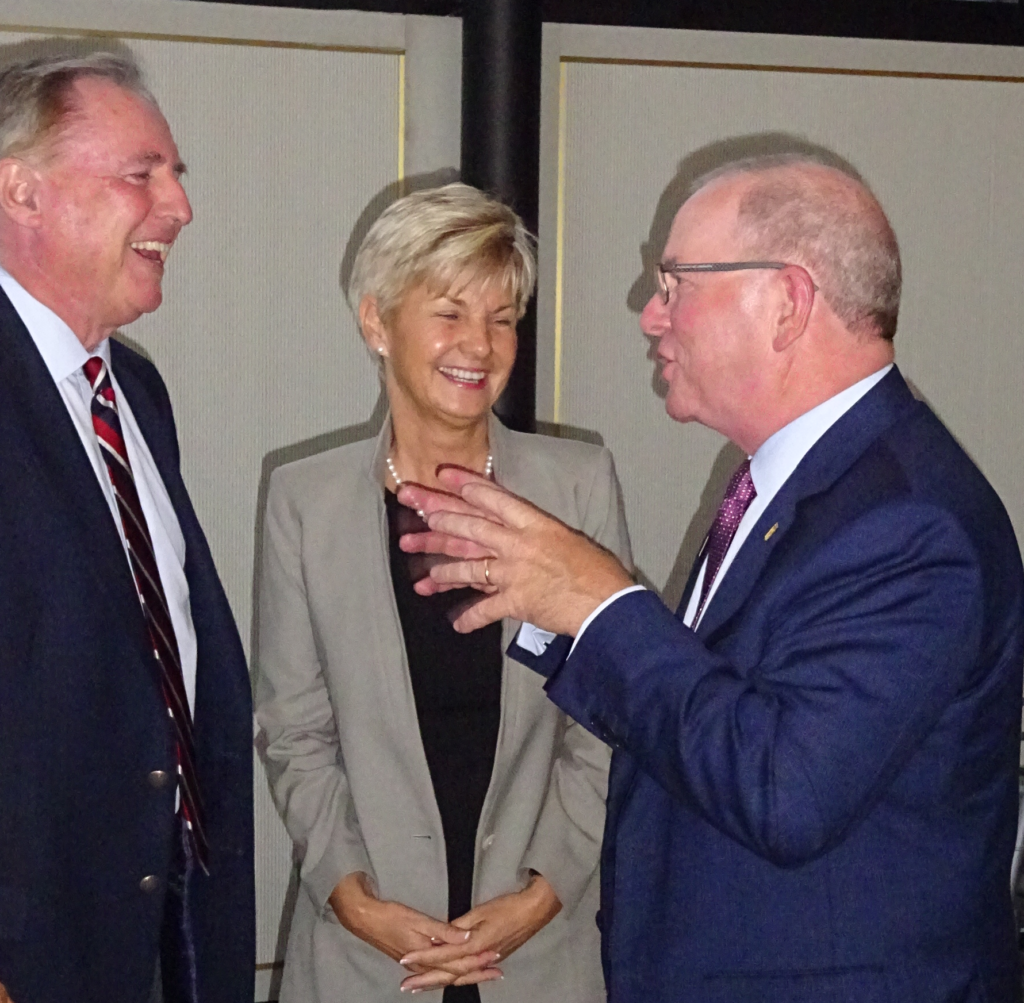 Ron Foxcroft on the left with Francine Dyksterhuis, Regional President of Southwestern Ontario, RBC and retiring Royal Bank vice president John Lever. “As leaders within our communities, both RBC and the Burlington Foundation, have the ability to bring attention to issues impacting the Halton community through research, speaking and convening,” says Francine Dyksterhuis, Regional President of Southwestern Ontario, RBC. “Working together has never been more urgent. All sectors must join forces and mobilize efforts, energy and expertise to improve near-term employment outcomes as well as develop the evolving hard and soft skills of our young people that will be required across all sectors.”
The partnership will include an innovative educational event this winter.

 By Ray Rivers By Ray Rivers
October 15th, 2017
BURLINGTON, ON
A couple of weeks ago Canada’s Heritage Minister, Mélanie Joly, announced the country’s new creative industries strategy. There was more money for Canada’s creative sector but for the most part she and her announcement have largely been ignored or panned.
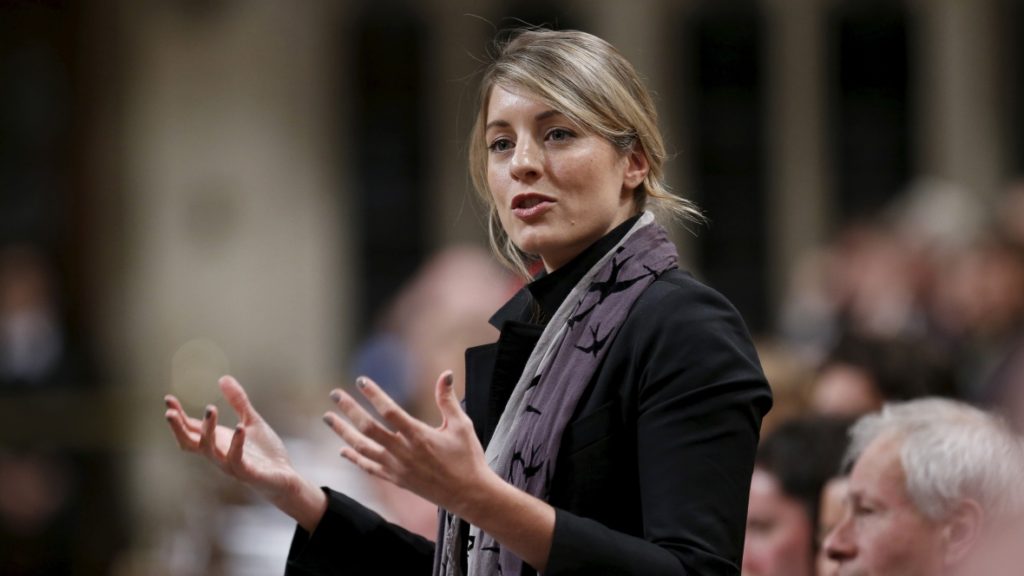 Heritage Minister, Mélanie Joly One reason could be how she has been dealing with Netflix and internet streaming more generally. With virtually unlimited global access through the internet, Netflix and Amazon can be broadcast right into anyone’s home and not be subject to the (HST) as are the TV and cable broadcasters. And by the same token these streaming companies can escape Canada’s outdated domestic content rules.
So the government wrangled some Canadian content into Netflix by getting the US based company to invest half a billion dollars over the next five years into Canadian productions. Details are scarce as hen’s teeth, leaving the impression that this is a deal still at the concept stage. But what about the taxation issue?
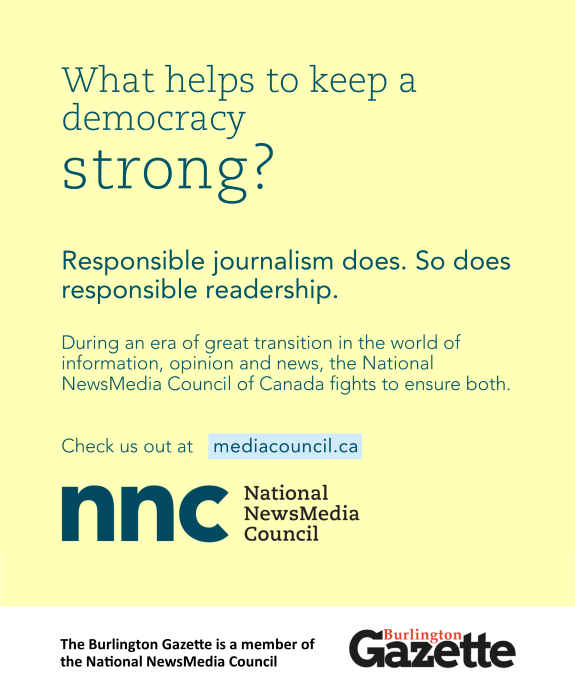 And what was really missing from her announcement is an indication as to how the government plans to deal with the evolution taking place with the daily news. The dailies are a dying breed as advertising revenue, circulation and employment are all in a downward spiral. And once the papers go, so too will the press associations which they support, the ones which provide front-line reporting of events upon which we should all depend. And what was really missing from her announcement is an indication as to how the government plans to deal with the evolution taking place with the daily news. The dailies are a dying breed as advertising revenue, circulation and employment are all in a downward spiral. And once the papers go, so too will the press associations which they support, the ones which provide front-line reporting of events upon which we should all depend.
Some broadcasters like our own CBC utilize their own staff reporters for many stories, and don’t rely solely on the Canadian press service. But broadcast news is also facing challenges, especially in the US, where the president has called what the networks report as ‘Fake News” and has threatened to pull their broadcasting licenses.
Of course he can’t really do that, given the arms length relationship between him and them, and those in that country who do manage media policy. And besides there is that constitutional first amendment. But what he has done with his bluster is erode the public’s confidence in conventional news media and create confusion about what President Trump’s people have called alternate facts.
Those alternate facts have abounded on social media, particularly given the intrusion into the US domestic social networks by the Russians. Even if we disregard those kinds of malicious and fraudulent cyber postings as transitional, there is a plethora of blogs and opinion pieces which masquerade as facts, and serve only to distort the truth.
 American President’s used to hold “Fireside” chats and talk to the public. Donald Trump chooses to tweet and tweet and tweet. Trump, is reported to only watch the Fox News TV channel, a network many mock for its misnomer of a moniker – ‘fair and balanced’. And he prefers to release his own news reports via Twitter from the peace and comfort of his inner sanctum in the White House, rather than at a news conference where reporters can clarify and ask questions. After all, he is the president.
Democracy resides on a three legged platform. Universal suffrage is one leg, the freedom to run as a candidate another. And the free communication of accurate information makes up the final support. Facts are critical, and it is fair game for opinion writers to interpret to their hearts’ content, within the bounds of reasonableness. But there is no such animal as an alternate fact.
 Does Netflix dominate? Canada has been well served by our traditional mixed media, a government owned public broadcaster provides balance to the private paper giants – and they in turn provide a check that the GBG/Radio Canada sticks to the message and doesn’t get seduced by who is providing the pay cheques. Perhaps that is why consideration of this aspect of our communications sector escaped the Heritage minister’s attention.
But even the giants are hurting and there are things a government can do help slow down the bleeding, such as greater advertising purchases. And fair taxation is just as important among the internet and other media as it is for small incorporated business owners.
That is something our negotiators need to keep in mind as they plod their way through these difficult NAFTA negotiations. After all, as the old adage goes, news is what’s in the newspapers.
 Ray Rivers writes weekly on both federal and provincial politics, applying his more than 25 years as a federal bureaucrat to his thinking. Rivers was a candidate for provincial office in Burlington in 1995. He was the founder of the Burlington citizen committee on sustainability at a time when climate warming was a hotly debated subject. Tweet @rayzrivers Ray Rivers writes weekly on both federal and provincial politics, applying his more than 25 years as a federal bureaucrat to his thinking. Rivers was a candidate for provincial office in Burlington in 1995. He was the founder of the Burlington citizen committee on sustainability at a time when climate warming was a hotly debated subject. Tweet @rayzrivers
Background links:
Turkey Talk and Rookie Ministers – Canadian Content – Canadian Content Updating – Canadian Press – Periodical Fund – Newspaper Ask –
Media Funding – Faking News – State of US Media – Threat to First Amendment –

 By Pepper Parr By Pepper Parr
October 10th, 2017
BURLINGTON, ON
It was promoted as the “Official Opening” of the Joseph Brant Hospital; the television cameras were on hand with more guest chairs than one usually sees set out for this kind of event.
The Premier wasn’t on hand to turn over a cheque – the hospital has gotten all it is likely to get from the provincial government for some time.
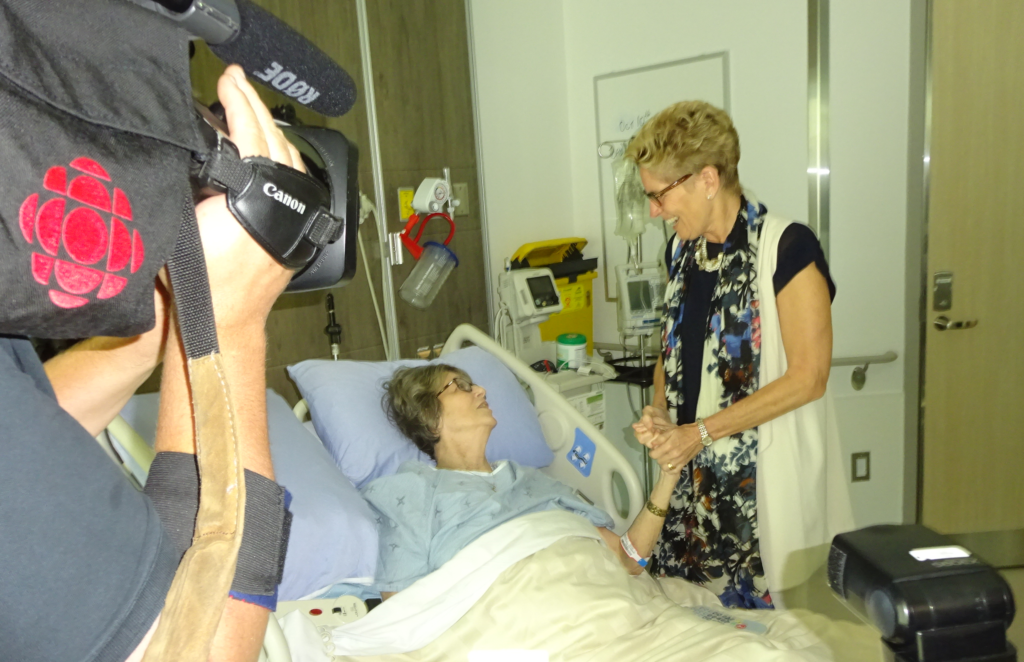 Premier doing one of those Photo Ops – while checking in on a patient. The Premier was there to do a tour of the new digs and to have one of those photo op conversations with a patient.
This was the first occasion we had to tour the new building – and it is very smart looking. A lot of effort went into making it look and feel like a nice place to be if you aren’t well.
People comment favourably over the view – most seeing the lake as the best side. Once you’ve seen a stretch of water what else is there to see other than a sunrise.
The view from the escarpment side are very very nice.
The corridors are wide, the colour scheme is soft, welcoming.
The rooms are large, really large.
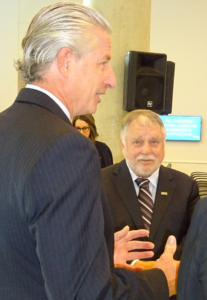 Hospital president and CEO Eric Vandewall and MP Ted McMeekin It is certainly a huge, huge improvement over what people had to put up with. Eric Vandewall has every reason to be proud of what he has done. Vandewall is quick to credit the team he had working with him – the job wouldn’t have been done as well as it was done without Vandewall’s leadership.
The Hospital Foundation now needs to round up a couple more million to complete the raising of the $60 million they were tasked with.
The next step for the hospital is to make itself a Centre of Excellence and show that this hospital is a lot different than what the public had to put up with.
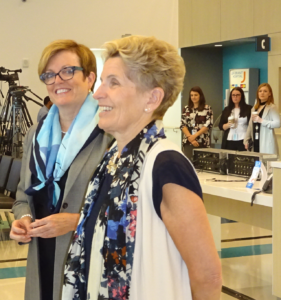 The Premier seemed to be a little off her mettle this morning. 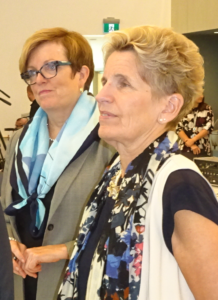 She didn’t sparkle. She seemed tired. The Premier seemed to be a little off her mettle this morning. She didn’t sparkle. She seemed tired.
Ted McMeekin, her Loyal Servant and Subject was on hand to greet her when she walked in the new entrance.
He was joined by Kevin Flynn, Minister of Labour, Eleanor McMahon, Burlington MPP and Minister of Tourism Culture and Sport along with Eric Vandewall, President and CEO of the Hospital and Chair of the Hospital Board Kathryn Osborne.
The Premier was in Burlington to tour the hospital and comment on the end of another busy construction season, celebrating significant progress on many hospital, school, transit, road and bridge projects across the province.
For this she came to Burlington?

|
|
 By Lisa Kearns
By Lisa Kearns Aaron A. Moore, Phd and expert on urban politics and public policy penned the IMFG Paper on Municipal Finance and Governance said the most common rationales used to invoke and justify the use of Section 37, more broadly know as density bonusing are:
Aaron A. Moore, Phd and expert on urban politics and public policy penned the IMFG Paper on Municipal Finance and Governance said the most common rationales used to invoke and justify the use of Section 37, more broadly know as density bonusing are: • $150K in streetscape improvements coupled with $250K in setbacks/widened view corridors.
• $150K in streetscape improvements coupled with $250K in setbacks/widened view corridors.

 Lisa Kerns is a downtown Burlington resident and an active member of ECoB – Engaged Citizens of Burlington. She is also a self admitted policy wonk – she digs and figures out just what much of the baffle-gab means.
Lisa Kerns is a downtown Burlington resident and an active member of ECoB – Engaged Citizens of Burlington. She is also a self admitted policy wonk – she digs and figures out just what much of the baffle-gab means.




















 Bfast has been advocating for better transit for years – some of the people in the organization know more about the history of transit in Burlington better than anyone currently employed at the transit department.
Bfast has been advocating for better transit for years – some of the people in the organization know more about the history of transit in Burlington better than anyone currently employed at the transit department.






 Burlington’s new transit director Sue Connor, a woman with a real transit pedigree will outline her plan of action for repairing and improving the system when she speaks at the Fourth Annual Transit Users’ Forum Apr. 21.
Burlington’s new transit director Sue Connor, a woman with a real transit pedigree will outline her plan of action for repairing and improving the system when she speaks at the Fourth Annual Transit Users’ Forum Apr. 21.

















 Thursday, March 8, 2018, 7:00 – 8:30 pm at the Burlington Performing Arts Centre
Thursday, March 8, 2018, 7:00 – 8:30 pm at the Burlington Performing Arts Centre
 This is a FREE event open to all, with voluntary non-perishable food donations being collected in support of Burlington Food Bank.
This is a FREE event open to all, with voluntary non-perishable food donations being collected in support of Burlington Food Bank. Burlington tax increases have been hovering at the 3 to 4% annual tax increases for much of the two terms the current council has been in office.
Burlington tax increases have been hovering at the 3 to 4% annual tax increases for much of the two terms the current council has been in office. • Investing in infrastructure and maintenance – in accordance with the city’s Asset Management Plan, the dedicated infrastructure levy has been increased by 1.25 per cent or $1.9 million. Of the $160.1 million collected through the tax levy, $34.72 million will fund the capital program and renewing Burlington’s aging infrastructure.
• Investing in infrastructure and maintenance – in accordance with the city’s Asset Management Plan, the dedicated infrastructure levy has been increased by 1.25 per cent or $1.9 million. Of the $160.1 million collected through the tax levy, $34.72 million will fund the capital program and renewing Burlington’s aging infrastructure. • Community investment and growth – to provide an additional investment of $320,000 to enhance the maintenance of sports fields.
• Community investment and growth – to provide an additional investment of $320,000 to enhance the maintenance of sports fields. • Financial sustainability – Burlington’s operating budget is committed to ensuring the city has competitive property taxes. Since 2011, overall tax increases in Burlington have averaged 1.9 per cent. In a comparison of property taxes in municipalities in the Greater Toronto and Hamilton Area, Burlington’s property taxes are the third-lowest for a residential single-family detached home.
• Financial sustainability – Burlington’s operating budget is committed to ensuring the city has competitive property taxes. Since 2011, overall tax increases in Burlington have averaged 1.9 per cent. In a comparison of property taxes in municipalities in the Greater Toronto and Hamilton Area, Burlington’s property taxes are the third-lowest for a residential single-family detached home.



 Other impacts to the 2018 operating budget include:
Other impacts to the 2018 operating budget include: The total city tax increase in the proposed 2018 operating budget is 4.19 per cent. When combined with Halton Region’s proposed tax increase and no change for education, the overall tax increase is projected at 2.49 per cent or $21.03 per $100,000 of Current Value Assessment.
The total city tax increase in the proposed 2018 operating budget is 4.19 per cent. When combined with Halton Region’s proposed tax increase and no change for education, the overall tax increase is projected at 2.49 per cent or $21.03 per $100,000 of Current Value Assessment.





 The cost increases put upward pressure on the budget; more money going out. The lower than anticipated assessment growth meant less money coming in. The difference between those two numbers is found in the pockets of the tax payers.
The cost increases put upward pressure on the budget; more money going out. The lower than anticipated assessment growth meant less money coming in. The difference between those two numbers is found in the pockets of the tax payers.




















 And what was really missing from her announcement is an indication as to how the government plans to deal with the evolution taking place with the daily news. The dailies are a dying breed as advertising revenue, circulation and employment are all in a downward spiral. And once the papers go, so too will the press associations which they support, the ones which provide front-line reporting of events upon which we should all depend.
And what was really missing from her announcement is an indication as to how the government plans to deal with the evolution taking place with the daily news. The dailies are a dying breed as advertising revenue, circulation and employment are all in a downward spiral. And once the papers go, so too will the press associations which they support, the ones which provide front-line reporting of events upon which we should all depend.

 Ray Rivers writes weekly on both federal and provincial politics, applying his more than 25 years as a federal bureaucrat to his thinking. Rivers was a candidate for provincial office in Burlington in 1995. He was the founder of the Burlington citizen committee on sustainability at a time when climate warming was a hotly debated subject. Tweet @rayzrivers
Ray Rivers writes weekly on both federal and provincial politics, applying his more than 25 years as a federal bureaucrat to his thinking. Rivers was a candidate for provincial office in Burlington in 1995. He was the founder of the Burlington citizen committee on sustainability at a time when climate warming was a hotly debated subject. Tweet @rayzrivers



